Discrimination and Legislations
VerifiedAdded on 2023/06/12
|26
|9657
|438
AI Summary
This article discusses the laws in relation to discrimination in Australia, including the primary legislations that deal with anti-discrimination laws. It also analyzes discrimination on Hollywood movies and the legislation and exemption screening in Australian cinemas in relation to discrimination acts.
Contribute Materials
Your contribution can guide someone’s learning journey. Share your
documents today.

Running head: DISCRIMINATION AND LEGISLATIONS
Discrimination and Legislations
Name of the Student:
Name of the University:
Author’s Note:
Discrimination and Legislations
Name of the Student:
Name of the University:
Author’s Note:
Secure Best Marks with AI Grader
Need help grading? Try our AI Grader for instant feedback on your assignments.
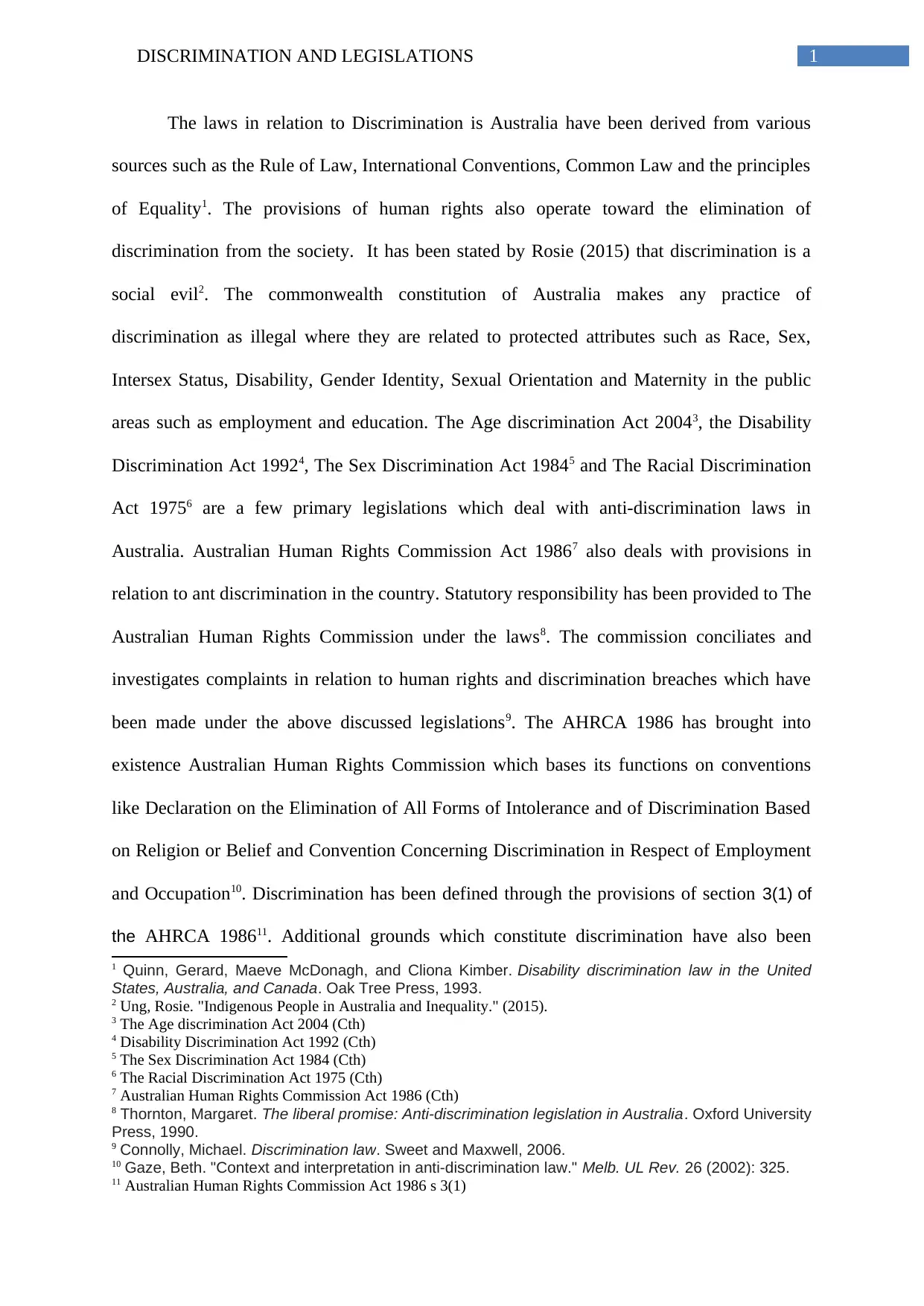
1DISCRIMINATION AND LEGISLATIONS
The laws in relation to Discrimination is Australia have been derived from various
sources such as the Rule of Law, International Conventions, Common Law and the principles
of Equality1. The provisions of human rights also operate toward the elimination of
discrimination from the society. It has been stated by Rosie (2015) that discrimination is a
social evil2. The commonwealth constitution of Australia makes any practice of
discrimination as illegal where they are related to protected attributes such as Race, Sex,
Intersex Status, Disability, Gender Identity, Sexual Orientation and Maternity in the public
areas such as employment and education. The Age discrimination Act 20043, the Disability
Discrimination Act 19924, The Sex Discrimination Act 19845 and The Racial Discrimination
Act 19756 are a few primary legislations which deal with anti-discrimination laws in
Australia. Australian Human Rights Commission Act 19867 also deals with provisions in
relation to ant discrimination in the country. Statutory responsibility has been provided to The
Australian Human Rights Commission under the laws8. The commission conciliates and
investigates complaints in relation to human rights and discrimination breaches which have
been made under the above discussed legislations9. The AHRCA 1986 has brought into
existence Australian Human Rights Commission which bases its functions on conventions
like Declaration on the Elimination of All Forms of Intolerance and of Discrimination Based
on Religion or Belief and Convention Concerning Discrimination in Respect of Employment
and Occupation10. Discrimination has been defined through the provisions of section 3(1) of
the AHRCA 198611. Additional grounds which constitute discrimination have also been
1 Quinn, Gerard, Maeve McDonagh, and Cliona Kimber. Disability discrimination law in the United
States, Australia, and Canada. Oak Tree Press, 1993.
2 Ung, Rosie. "Indigenous People in Australia and Inequality." (2015).
3 The Age discrimination Act 2004 (Cth)
4 Disability Discrimination Act 1992 (Cth)
5 The Sex Discrimination Act 1984 (Cth)
6 The Racial Discrimination Act 1975 (Cth)
7 Australian Human Rights Commission Act 1986 (Cth)
8 Thornton, Margaret. The liberal promise: Anti-discrimination legislation in Australia. Oxford University
Press, 1990.
9 Connolly, Michael. Discrimination law. Sweet and Maxwell, 2006.
10 Gaze, Beth. "Context and interpretation in anti-discrimination law." Melb. UL Rev. 26 (2002): 325.
11 Australian Human Rights Commission Act 1986 s 3(1)
The laws in relation to Discrimination is Australia have been derived from various
sources such as the Rule of Law, International Conventions, Common Law and the principles
of Equality1. The provisions of human rights also operate toward the elimination of
discrimination from the society. It has been stated by Rosie (2015) that discrimination is a
social evil2. The commonwealth constitution of Australia makes any practice of
discrimination as illegal where they are related to protected attributes such as Race, Sex,
Intersex Status, Disability, Gender Identity, Sexual Orientation and Maternity in the public
areas such as employment and education. The Age discrimination Act 20043, the Disability
Discrimination Act 19924, The Sex Discrimination Act 19845 and The Racial Discrimination
Act 19756 are a few primary legislations which deal with anti-discrimination laws in
Australia. Australian Human Rights Commission Act 19867 also deals with provisions in
relation to ant discrimination in the country. Statutory responsibility has been provided to The
Australian Human Rights Commission under the laws8. The commission conciliates and
investigates complaints in relation to human rights and discrimination breaches which have
been made under the above discussed legislations9. The AHRCA 1986 has brought into
existence Australian Human Rights Commission which bases its functions on conventions
like Declaration on the Elimination of All Forms of Intolerance and of Discrimination Based
on Religion or Belief and Convention Concerning Discrimination in Respect of Employment
and Occupation10. Discrimination has been defined through the provisions of section 3(1) of
the AHRCA 198611. Additional grounds which constitute discrimination have also been
1 Quinn, Gerard, Maeve McDonagh, and Cliona Kimber. Disability discrimination law in the United
States, Australia, and Canada. Oak Tree Press, 1993.
2 Ung, Rosie. "Indigenous People in Australia and Inequality." (2015).
3 The Age discrimination Act 2004 (Cth)
4 Disability Discrimination Act 1992 (Cth)
5 The Sex Discrimination Act 1984 (Cth)
6 The Racial Discrimination Act 1975 (Cth)
7 Australian Human Rights Commission Act 1986 (Cth)
8 Thornton, Margaret. The liberal promise: Anti-discrimination legislation in Australia. Oxford University
Press, 1990.
9 Connolly, Michael. Discrimination law. Sweet and Maxwell, 2006.
10 Gaze, Beth. "Context and interpretation in anti-discrimination law." Melb. UL Rev. 26 (2002): 325.
11 Australian Human Rights Commission Act 1986 s 3(1)
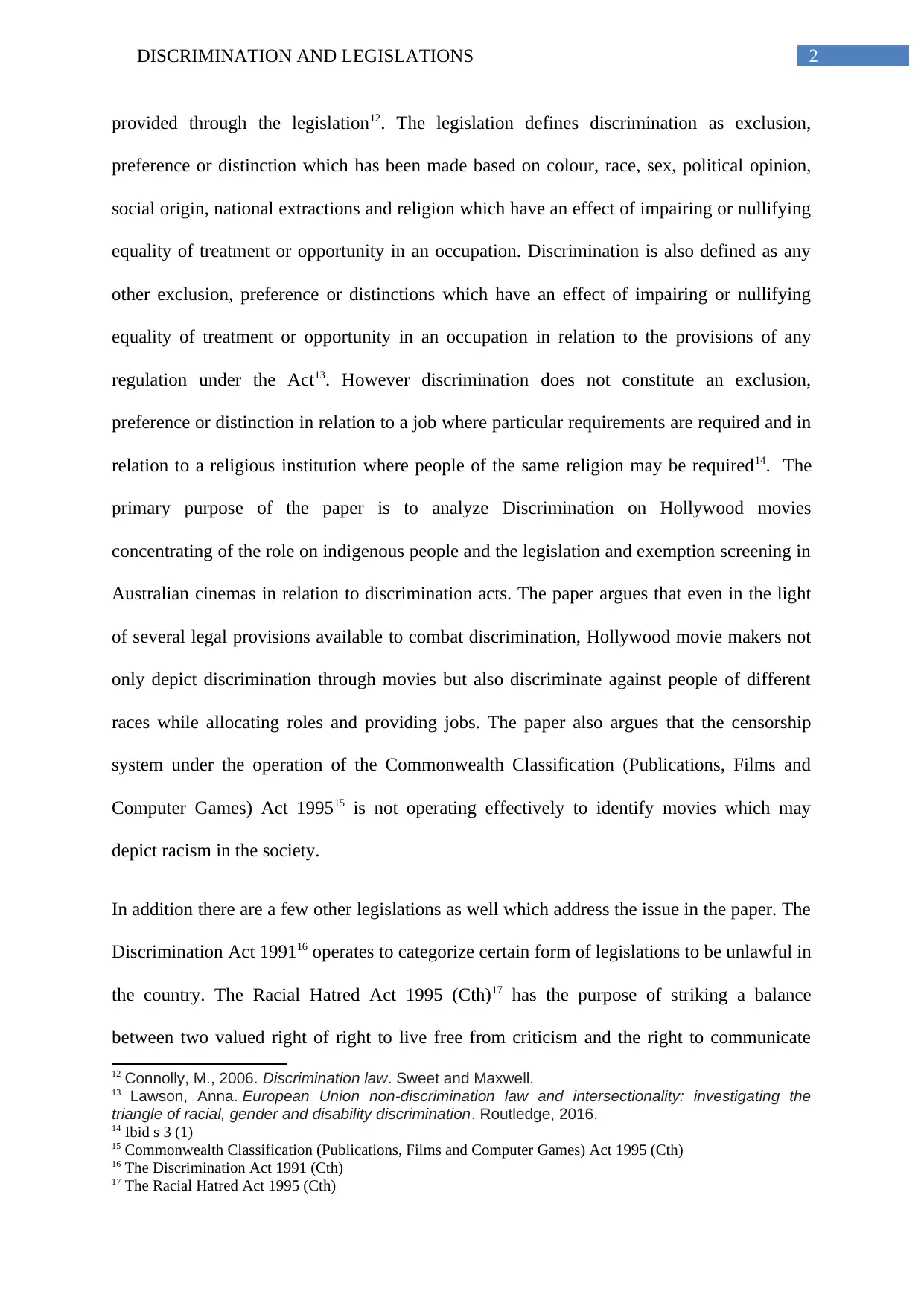
2DISCRIMINATION AND LEGISLATIONS
provided through the legislation12. The legislation defines discrimination as exclusion,
preference or distinction which has been made based on colour, race, sex, political opinion,
social origin, national extractions and religion which have an effect of impairing or nullifying
equality of treatment or opportunity in an occupation. Discrimination is also defined as any
other exclusion, preference or distinctions which have an effect of impairing or nullifying
equality of treatment or opportunity in an occupation in relation to the provisions of any
regulation under the Act13. However discrimination does not constitute an exclusion,
preference or distinction in relation to a job where particular requirements are required and in
relation to a religious institution where people of the same religion may be required14. The
primary purpose of the paper is to analyze Discrimination on Hollywood movies
concentrating of the role on indigenous people and the legislation and exemption screening in
Australian cinemas in relation to discrimination acts. The paper argues that even in the light
of several legal provisions available to combat discrimination, Hollywood movie makers not
only depict discrimination through movies but also discriminate against people of different
races while allocating roles and providing jobs. The paper also argues that the censorship
system under the operation of the Commonwealth Classification (Publications, Films and
Computer Games) Act 199515 is not operating effectively to identify movies which may
depict racism in the society.
In addition there are a few other legislations as well which address the issue in the paper. The
Discrimination Act 199116 operates to categorize certain form of legislations to be unlawful in
the country. The Racial Hatred Act 1995 (Cth)17 has the purpose of striking a balance
between two valued right of right to live free from criticism and the right to communicate
12 Connolly, M., 2006. Discrimination law. Sweet and Maxwell.
13 Lawson, Anna. European Union non-discrimination law and intersectionality: investigating the
triangle of racial, gender and disability discrimination. Routledge, 2016.
14 Ibid s 3 (1)
15 Commonwealth Classification (Publications, Films and Computer Games) Act 1995 (Cth)
16 The Discrimination Act 1991 (Cth)
17 The Racial Hatred Act 1995 (Cth)
provided through the legislation12. The legislation defines discrimination as exclusion,
preference or distinction which has been made based on colour, race, sex, political opinion,
social origin, national extractions and religion which have an effect of impairing or nullifying
equality of treatment or opportunity in an occupation. Discrimination is also defined as any
other exclusion, preference or distinctions which have an effect of impairing or nullifying
equality of treatment or opportunity in an occupation in relation to the provisions of any
regulation under the Act13. However discrimination does not constitute an exclusion,
preference or distinction in relation to a job where particular requirements are required and in
relation to a religious institution where people of the same religion may be required14. The
primary purpose of the paper is to analyze Discrimination on Hollywood movies
concentrating of the role on indigenous people and the legislation and exemption screening in
Australian cinemas in relation to discrimination acts. The paper argues that even in the light
of several legal provisions available to combat discrimination, Hollywood movie makers not
only depict discrimination through movies but also discriminate against people of different
races while allocating roles and providing jobs. The paper also argues that the censorship
system under the operation of the Commonwealth Classification (Publications, Films and
Computer Games) Act 199515 is not operating effectively to identify movies which may
depict racism in the society.
In addition there are a few other legislations as well which address the issue in the paper. The
Discrimination Act 199116 operates to categorize certain form of legislations to be unlawful in
the country. The Racial Hatred Act 1995 (Cth)17 has the purpose of striking a balance
between two valued right of right to live free from criticism and the right to communicate
12 Connolly, M., 2006. Discrimination law. Sweet and Maxwell.
13 Lawson, Anna. European Union non-discrimination law and intersectionality: investigating the
triangle of racial, gender and disability discrimination. Routledge, 2016.
14 Ibid s 3 (1)
15 Commonwealth Classification (Publications, Films and Computer Games) Act 1995 (Cth)
16 The Discrimination Act 1991 (Cth)
17 The Racial Hatred Act 1995 (Cth)
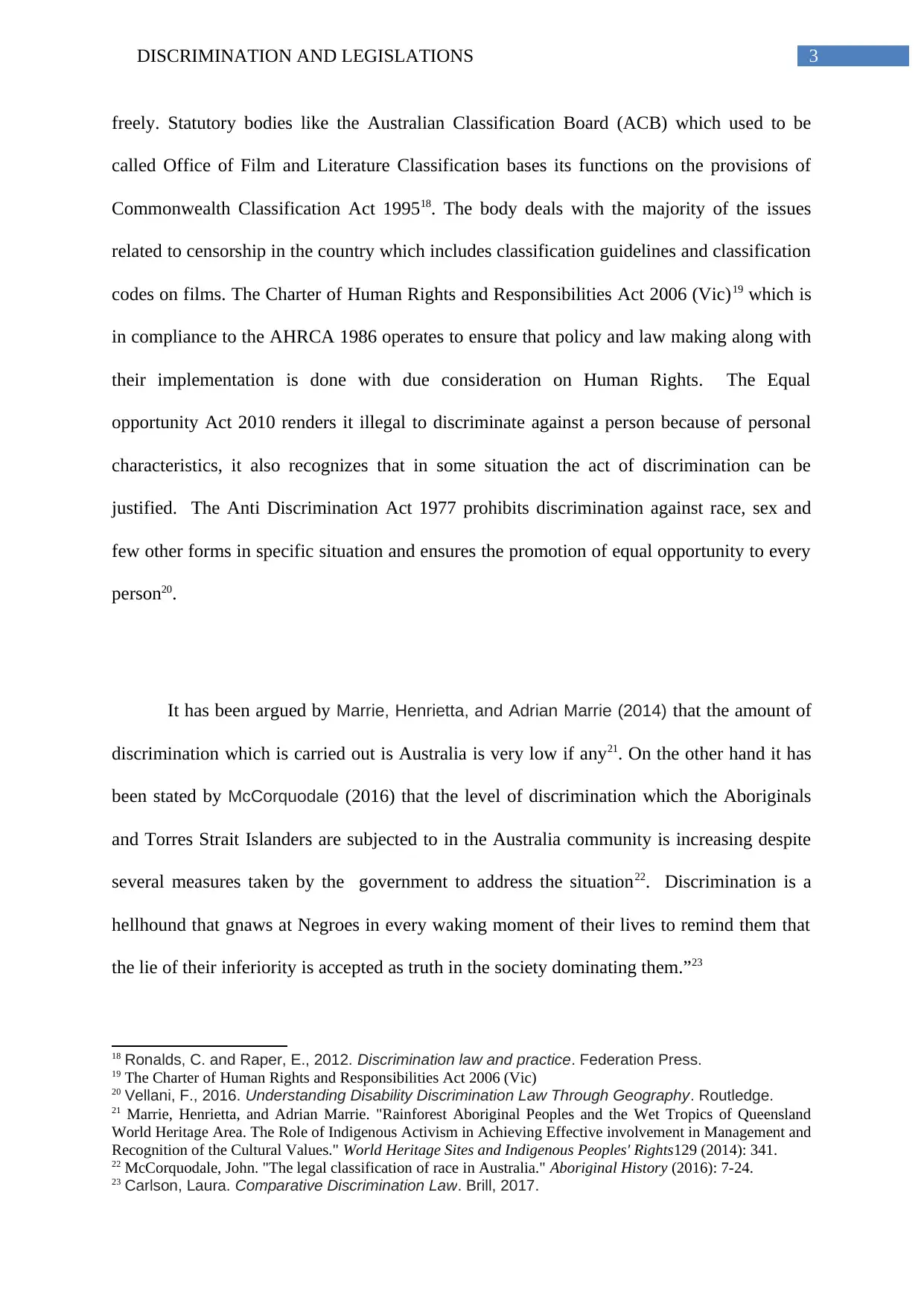
3DISCRIMINATION AND LEGISLATIONS
freely. Statutory bodies like the Australian Classification Board (ACB) which used to be
called Office of Film and Literature Classification bases its functions on the provisions of
Commonwealth Classification Act 199518. The body deals with the majority of the issues
related to censorship in the country which includes classification guidelines and classification
codes on films. The Charter of Human Rights and Responsibilities Act 2006 (Vic)19 which is
in compliance to the AHRCA 1986 operates to ensure that policy and law making along with
their implementation is done with due consideration on Human Rights. The Equal
opportunity Act 2010 renders it illegal to discriminate against a person because of personal
characteristics, it also recognizes that in some situation the act of discrimination can be
justified. The Anti Discrimination Act 1977 prohibits discrimination against race, sex and
few other forms in specific situation and ensures the promotion of equal opportunity to every
person20.
It has been argued by Marrie, Henrietta, and Adrian Marrie (2014) that the amount of
discrimination which is carried out is Australia is very low if any21. On the other hand it has
been stated by McCorquodale (2016) that the level of discrimination which the Aboriginals
and Torres Strait Islanders are subjected to in the Australia community is increasing despite
several measures taken by the government to address the situation22. Discrimination is a
hellhound that gnaws at Negroes in every waking moment of their lives to remind them that
the lie of their inferiority is accepted as truth in the society dominating them.”23
18 Ronalds, C. and Raper, E., 2012. Discrimination law and practice. Federation Press.
19 The Charter of Human Rights and Responsibilities Act 2006 (Vic)
20 Vellani, F., 2016. Understanding Disability Discrimination Law Through Geography. Routledge.
21 Marrie, Henrietta, and Adrian Marrie. "Rainforest Aboriginal Peoples and the Wet Tropics of Queensland
World Heritage Area. The Role of Indigenous Activism in Achieving Effective involvement in Management and
Recognition of the Cultural Values." World Heritage Sites and Indigenous Peoples' Rights129 (2014): 341.
22 McCorquodale, John. "The legal classification of race in Australia." Aboriginal History (2016): 7-24.
23 Carlson, Laura. Comparative Discrimination Law. Brill, 2017.
freely. Statutory bodies like the Australian Classification Board (ACB) which used to be
called Office of Film and Literature Classification bases its functions on the provisions of
Commonwealth Classification Act 199518. The body deals with the majority of the issues
related to censorship in the country which includes classification guidelines and classification
codes on films. The Charter of Human Rights and Responsibilities Act 2006 (Vic)19 which is
in compliance to the AHRCA 1986 operates to ensure that policy and law making along with
their implementation is done with due consideration on Human Rights. The Equal
opportunity Act 2010 renders it illegal to discriminate against a person because of personal
characteristics, it also recognizes that in some situation the act of discrimination can be
justified. The Anti Discrimination Act 1977 prohibits discrimination against race, sex and
few other forms in specific situation and ensures the promotion of equal opportunity to every
person20.
It has been argued by Marrie, Henrietta, and Adrian Marrie (2014) that the amount of
discrimination which is carried out is Australia is very low if any21. On the other hand it has
been stated by McCorquodale (2016) that the level of discrimination which the Aboriginals
and Torres Strait Islanders are subjected to in the Australia community is increasing despite
several measures taken by the government to address the situation22. Discrimination is a
hellhound that gnaws at Negroes in every waking moment of their lives to remind them that
the lie of their inferiority is accepted as truth in the society dominating them.”23
18 Ronalds, C. and Raper, E., 2012. Discrimination law and practice. Federation Press.
19 The Charter of Human Rights and Responsibilities Act 2006 (Vic)
20 Vellani, F., 2016. Understanding Disability Discrimination Law Through Geography. Routledge.
21 Marrie, Henrietta, and Adrian Marrie. "Rainforest Aboriginal Peoples and the Wet Tropics of Queensland
World Heritage Area. The Role of Indigenous Activism in Achieving Effective involvement in Management and
Recognition of the Cultural Values." World Heritage Sites and Indigenous Peoples' Rights129 (2014): 341.
22 McCorquodale, John. "The legal classification of race in Australia." Aboriginal History (2016): 7-24.
23 Carlson, Laura. Comparative Discrimination Law. Brill, 2017.
Secure Best Marks with AI Grader
Need help grading? Try our AI Grader for instant feedback on your assignments.
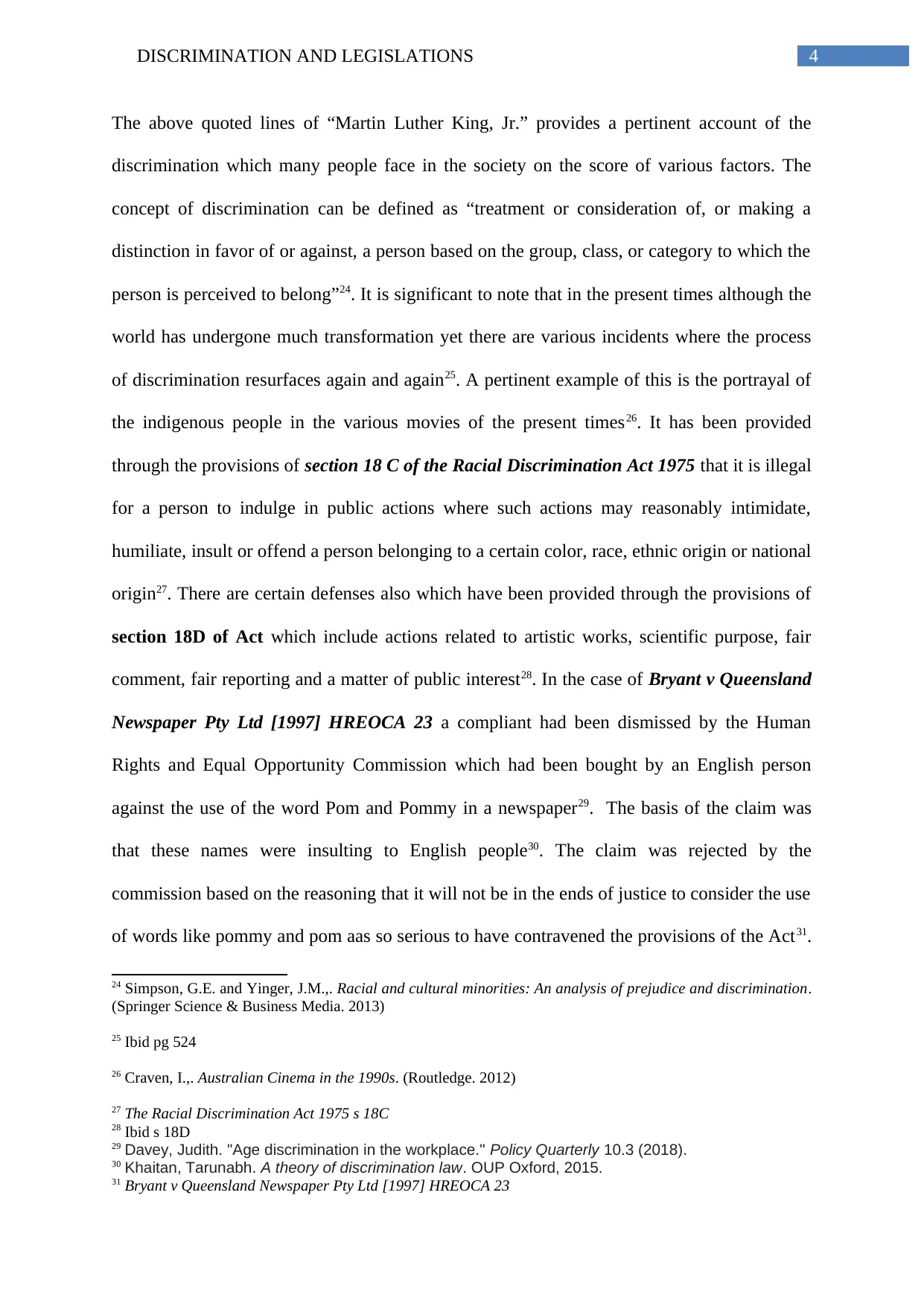
4DISCRIMINATION AND LEGISLATIONS
The above quoted lines of “Martin Luther King, Jr.” provides a pertinent account of the
discrimination which many people face in the society on the score of various factors. The
concept of discrimination can be defined as “treatment or consideration of, or making a
distinction in favor of or against, a person based on the group, class, or category to which the
person is perceived to belong”24. It is significant to note that in the present times although the
world has undergone much transformation yet there are various incidents where the process
of discrimination resurfaces again and again25. A pertinent example of this is the portrayal of
the indigenous people in the various movies of the present times26. It has been provided
through the provisions of section 18 C of the Racial Discrimination Act 1975 that it is illegal
for a person to indulge in public actions where such actions may reasonably intimidate,
humiliate, insult or offend a person belonging to a certain color, race, ethnic origin or national
origin27. There are certain defenses also which have been provided through the provisions of
section 18D of Act which include actions related to artistic works, scientific purpose, fair
comment, fair reporting and a matter of public interest28. In the case of Bryant v Queensland
Newspaper Pty Ltd [1997] HREOCA 23 a compliant had been dismissed by the Human
Rights and Equal Opportunity Commission which had been bought by an English person
against the use of the word Pom and Pommy in a newspaper29. The basis of the claim was
that these names were insulting to English people30. The claim was rejected by the
commission based on the reasoning that it will not be in the ends of justice to consider the use
of words like pommy and pom aas so serious to have contravened the provisions of the Act31.
24 Simpson, G.E. and Yinger, J.M.,. Racial and cultural minorities: An analysis of prejudice and discrimination.
(Springer Science & Business Media. 2013)
25 Ibid pg 524
26 Craven, I.,. Australian Cinema in the 1990s. (Routledge. 2012)
27 The Racial Discrimination Act 1975 s 18C
28 Ibid s 18D
29 Davey, Judith. "Age discrimination in the workplace." Policy Quarterly 10.3 (2018).
30 Khaitan, Tarunabh. A theory of discrimination law. OUP Oxford, 2015.
31 Bryant v Queensland Newspaper Pty Ltd [1997] HREOCA 23
The above quoted lines of “Martin Luther King, Jr.” provides a pertinent account of the
discrimination which many people face in the society on the score of various factors. The
concept of discrimination can be defined as “treatment or consideration of, or making a
distinction in favor of or against, a person based on the group, class, or category to which the
person is perceived to belong”24. It is significant to note that in the present times although the
world has undergone much transformation yet there are various incidents where the process
of discrimination resurfaces again and again25. A pertinent example of this is the portrayal of
the indigenous people in the various movies of the present times26. It has been provided
through the provisions of section 18 C of the Racial Discrimination Act 1975 that it is illegal
for a person to indulge in public actions where such actions may reasonably intimidate,
humiliate, insult or offend a person belonging to a certain color, race, ethnic origin or national
origin27. There are certain defenses also which have been provided through the provisions of
section 18D of Act which include actions related to artistic works, scientific purpose, fair
comment, fair reporting and a matter of public interest28. In the case of Bryant v Queensland
Newspaper Pty Ltd [1997] HREOCA 23 a compliant had been dismissed by the Human
Rights and Equal Opportunity Commission which had been bought by an English person
against the use of the word Pom and Pommy in a newspaper29. The basis of the claim was
that these names were insulting to English people30. The claim was rejected by the
commission based on the reasoning that it will not be in the ends of justice to consider the use
of words like pommy and pom aas so serious to have contravened the provisions of the Act31.
24 Simpson, G.E. and Yinger, J.M.,. Racial and cultural minorities: An analysis of prejudice and discrimination.
(Springer Science & Business Media. 2013)
25 Ibid pg 524
26 Craven, I.,. Australian Cinema in the 1990s. (Routledge. 2012)
27 The Racial Discrimination Act 1975 s 18C
28 Ibid s 18D
29 Davey, Judith. "Age discrimination in the workplace." Policy Quarterly 10.3 (2018).
30 Khaitan, Tarunabh. A theory of discrimination law. OUP Oxford, 2015.
31 Bryant v Queensland Newspaper Pty Ltd [1997] HREOCA 23

5DISCRIMINATION AND LEGISLATIONS
Thus on the basis of these principles it can be stated that only when the portrayal of
indigenous people would be so serious that it would fall within the meaning of the Act would
it be considered as discrimination. However there are various other ways in which the
sentiments of the indigenous communities hurt through the use of Hollywood movies32.
Moreover, it is also seen that the various nations of the world as well as the individuals try to
suppress the movies which focus on the theme of the discrimination faced by the indigenous
people33. A pertinent example of this was the recent row which was caused with the news that
a colored individual would now play the role of the superhero “Spiderman” in the
“Spiderman” movie series. The provisions of the Equal opportunity Act 2010 renders it
illegal to discriminate against a person because of personal characteristics, it also recognizes
that in some situation the act of discrimination can be justified34. Part 5 of the EOA 2010
provides general exceptions along with exemptions from the prohibition of discrimination.
However the legislation does not certify any action which has been taken in the above
movie35. The exceptions would allow that where the role of the super hero is required to be a
white person than it is legally valid to accept a white person only in that role, however where
the role is general it there can be no such actions taken. In addition it is difficult to prove that
whether the role actually required a white person or it was general as the producers can easily
justify that they require a white person to do the role instead of an indigenous person.
However, on the contrary, there are movies which have a considerable impact in the recent
times due to their captivating portrayal of the life as well as the living conditions of the lives
of the indigenous people. A pertinent example of this is “Kunuk’s film, ‘Atanarjuat: The Fast
32 Soutphommasane, T., 2015. 40 years of the racial discrimination act. LSJ: Law Society of NSW
Journal, (8), p.20.
33 Ibid pg 212
34 Equal opportunity Act 2010 (Vic)
35 Ibid Part 5
Thus on the basis of these principles it can be stated that only when the portrayal of
indigenous people would be so serious that it would fall within the meaning of the Act would
it be considered as discrimination. However there are various other ways in which the
sentiments of the indigenous communities hurt through the use of Hollywood movies32.
Moreover, it is also seen that the various nations of the world as well as the individuals try to
suppress the movies which focus on the theme of the discrimination faced by the indigenous
people33. A pertinent example of this was the recent row which was caused with the news that
a colored individual would now play the role of the superhero “Spiderman” in the
“Spiderman” movie series. The provisions of the Equal opportunity Act 2010 renders it
illegal to discriminate against a person because of personal characteristics, it also recognizes
that in some situation the act of discrimination can be justified34. Part 5 of the EOA 2010
provides general exceptions along with exemptions from the prohibition of discrimination.
However the legislation does not certify any action which has been taken in the above
movie35. The exceptions would allow that where the role of the super hero is required to be a
white person than it is legally valid to accept a white person only in that role, however where
the role is general it there can be no such actions taken. In addition it is difficult to prove that
whether the role actually required a white person or it was general as the producers can easily
justify that they require a white person to do the role instead of an indigenous person.
However, on the contrary, there are movies which have a considerable impact in the recent
times due to their captivating portrayal of the life as well as the living conditions of the lives
of the indigenous people. A pertinent example of this is “Kunuk’s film, ‘Atanarjuat: The Fast
32 Soutphommasane, T., 2015. 40 years of the racial discrimination act. LSJ: Law Society of NSW
Journal, (8), p.20.
33 Ibid pg 212
34 Equal opportunity Act 2010 (Vic)
35 Ibid Part 5
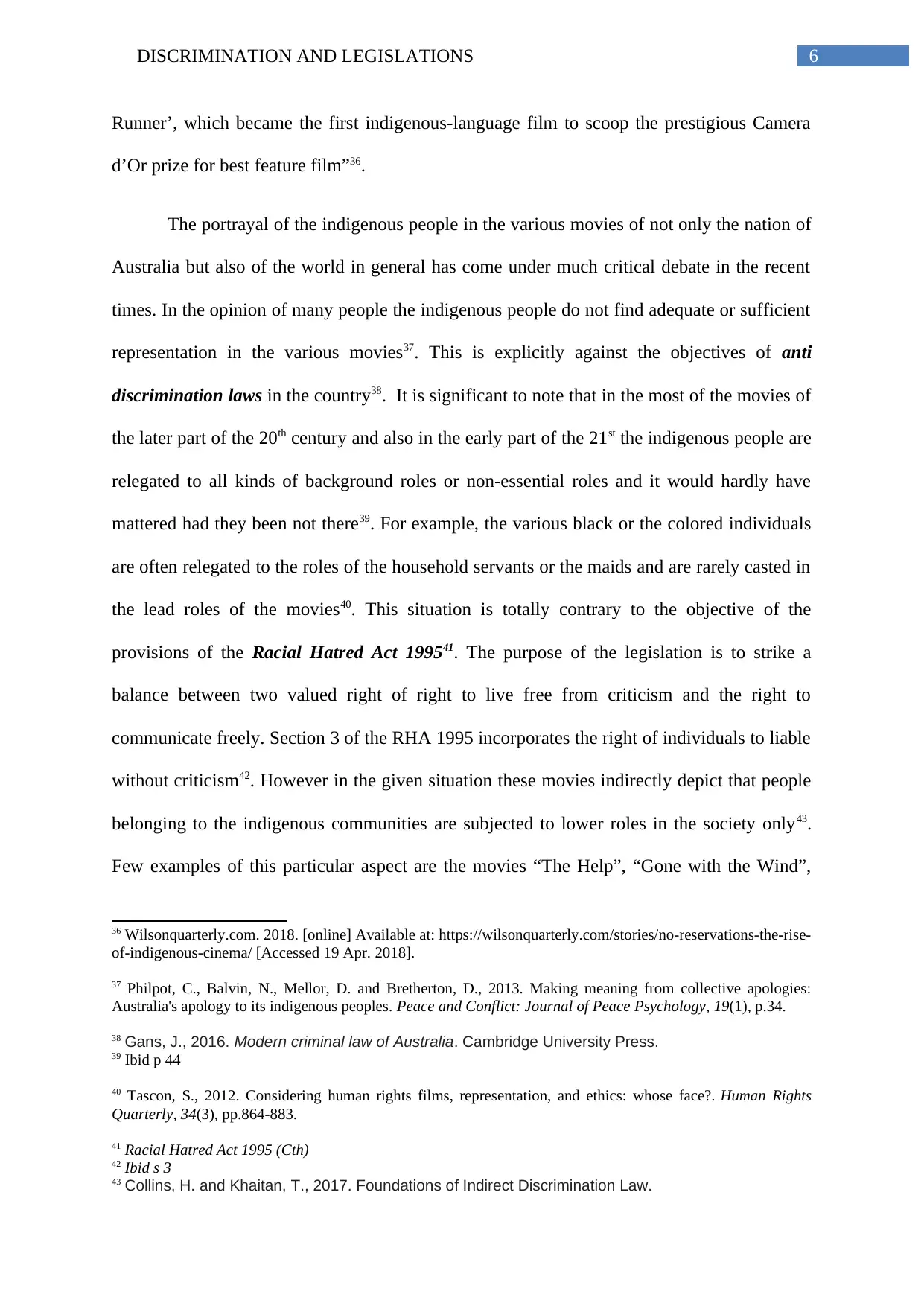
6DISCRIMINATION AND LEGISLATIONS
Runner’, which became the first indigenous-language film to scoop the prestigious Camera
d’Or prize for best feature film”36.
The portrayal of the indigenous people in the various movies of not only the nation of
Australia but also of the world in general has come under much critical debate in the recent
times. In the opinion of many people the indigenous people do not find adequate or sufficient
representation in the various movies37. This is explicitly against the objectives of anti
discrimination laws in the country38. It is significant to note that in the most of the movies of
the later part of the 20th century and also in the early part of the 21st the indigenous people are
relegated to all kinds of background roles or non-essential roles and it would hardly have
mattered had they been not there39. For example, the various black or the colored individuals
are often relegated to the roles of the household servants or the maids and are rarely casted in
the lead roles of the movies40. This situation is totally contrary to the objective of the
provisions of the Racial Hatred Act 199541. The purpose of the legislation is to strike a
balance between two valued right of right to live free from criticism and the right to
communicate freely. Section 3 of the RHA 1995 incorporates the right of individuals to liable
without criticism42. However in the given situation these movies indirectly depict that people
belonging to the indigenous communities are subjected to lower roles in the society only43.
Few examples of this particular aspect are the movies “The Help”, “Gone with the Wind”,
36 Wilsonquarterly.com. 2018. [online] Available at: https://wilsonquarterly.com/stories/no-reservations-the-rise-
of-indigenous-cinema/ [Accessed 19 Apr. 2018].
37 Philpot, C., Balvin, N., Mellor, D. and Bretherton, D., 2013. Making meaning from collective apologies:
Australia's apology to its indigenous peoples. Peace and Conflict: Journal of Peace Psychology, 19(1), p.34.
38 Gans, J., 2016. Modern criminal law of Australia. Cambridge University Press.
39 Ibid p 44
40 Tascon, S., 2012. Considering human rights films, representation, and ethics: whose face?. Human Rights
Quarterly, 34(3), pp.864-883.
41 Racial Hatred Act 1995 (Cth)
42 Ibid s 3
43 Collins, H. and Khaitan, T., 2017. Foundations of Indirect Discrimination Law.
Runner’, which became the first indigenous-language film to scoop the prestigious Camera
d’Or prize for best feature film”36.
The portrayal of the indigenous people in the various movies of not only the nation of
Australia but also of the world in general has come under much critical debate in the recent
times. In the opinion of many people the indigenous people do not find adequate or sufficient
representation in the various movies37. This is explicitly against the objectives of anti
discrimination laws in the country38. It is significant to note that in the most of the movies of
the later part of the 20th century and also in the early part of the 21st the indigenous people are
relegated to all kinds of background roles or non-essential roles and it would hardly have
mattered had they been not there39. For example, the various black or the colored individuals
are often relegated to the roles of the household servants or the maids and are rarely casted in
the lead roles of the movies40. This situation is totally contrary to the objective of the
provisions of the Racial Hatred Act 199541. The purpose of the legislation is to strike a
balance between two valued right of right to live free from criticism and the right to
communicate freely. Section 3 of the RHA 1995 incorporates the right of individuals to liable
without criticism42. However in the given situation these movies indirectly depict that people
belonging to the indigenous communities are subjected to lower roles in the society only43.
Few examples of this particular aspect are the movies “The Help”, “Gone with the Wind”,
36 Wilsonquarterly.com. 2018. [online] Available at: https://wilsonquarterly.com/stories/no-reservations-the-rise-
of-indigenous-cinema/ [Accessed 19 Apr. 2018].
37 Philpot, C., Balvin, N., Mellor, D. and Bretherton, D., 2013. Making meaning from collective apologies:
Australia's apology to its indigenous peoples. Peace and Conflict: Journal of Peace Psychology, 19(1), p.34.
38 Gans, J., 2016. Modern criminal law of Australia. Cambridge University Press.
39 Ibid p 44
40 Tascon, S., 2012. Considering human rights films, representation, and ethics: whose face?. Human Rights
Quarterly, 34(3), pp.864-883.
41 Racial Hatred Act 1995 (Cth)
42 Ibid s 3
43 Collins, H. and Khaitan, T., 2017. Foundations of Indirect Discrimination Law.
Paraphrase This Document
Need a fresh take? Get an instant paraphrase of this document with our AI Paraphraser

7DISCRIMINATION AND LEGISLATIONS
“The Shawshank Redemption (1994)” and others. The opinion of “Edith J. R.
Isaachs” articulated in his famous work “TheaterArts, August, 1942” becomes very
significant to note in this particular context when she says “Even today the motion picture has
not quite outgrown its immaturity. It still uses talented indigenous players to fit into the
stereotypes of the loving Mammy and comic servants”44. This also depicts that indigenous
people are being subjected to derogatory treatment in the society. In the case of Rugema v
Gadsten Pty [1997] HREOCA 34 the court had upheld an appeal made in relation to racial
discrimination. In this case the community had been addressed by derogatory words and the
court held that such situation accounts to racial discrimination. thus in the same way these
actions which are subjecting the indigenous or other races to shame are also liable to be
considered as discrimination45. Moreover movies like “Chinatown Nights” where white
individuals were used for the purpose of playing non white characters is another example of
the discrimination which is being meted out to the indigenous people in the contemporary
movies and cinemas. The actions which the producers indulged into with respect to this
movie were a clear breach of anti discrimination laws. In the case of Horman v Distribution
Group [2001] FMCA 52 the court held that where the line in relation to what a reasonable
person would feel as discrimination has been crossed a claim for discrimination is going to be
successful. Furthermore, in the movies like “Robert Montgomery Bird’s Nick of the Woods
(1837)”, “Samson & Delilah”, “Rabbit Proof Fence”, “Goldstone”, “Warwick Thornton's We
Don't Need A Map” and others where the colored as well as the indigenous people have
found a central stage yet they have been portrayed in a much sarcastic manner46. In the case
of Jones v Scully [2002] FCA 1080 it had been stated by the court that the distribution of
44 Farrior, Stephanie, ed. Equality and Non-discrimination Under International Law. Vol. 2. Routledge,
2017.
45 Rugema v Gadsten Pty [1997] HREOCA 34
46 NITV. 2018. 5 Indigenous films that changed the national conversation. [online] Available at:
https://www.sbs.com.au/nitv/article/2017/07/18/5-indigenous-films-changed-national-conversation [Accessed
21 Apr. 2018].
“The Shawshank Redemption (1994)” and others. The opinion of “Edith J. R.
Isaachs” articulated in his famous work “TheaterArts, August, 1942” becomes very
significant to note in this particular context when she says “Even today the motion picture has
not quite outgrown its immaturity. It still uses talented indigenous players to fit into the
stereotypes of the loving Mammy and comic servants”44. This also depicts that indigenous
people are being subjected to derogatory treatment in the society. In the case of Rugema v
Gadsten Pty [1997] HREOCA 34 the court had upheld an appeal made in relation to racial
discrimination. In this case the community had been addressed by derogatory words and the
court held that such situation accounts to racial discrimination. thus in the same way these
actions which are subjecting the indigenous or other races to shame are also liable to be
considered as discrimination45. Moreover movies like “Chinatown Nights” where white
individuals were used for the purpose of playing non white characters is another example of
the discrimination which is being meted out to the indigenous people in the contemporary
movies and cinemas. The actions which the producers indulged into with respect to this
movie were a clear breach of anti discrimination laws. In the case of Horman v Distribution
Group [2001] FMCA 52 the court held that where the line in relation to what a reasonable
person would feel as discrimination has been crossed a claim for discrimination is going to be
successful. Furthermore, in the movies like “Robert Montgomery Bird’s Nick of the Woods
(1837)”, “Samson & Delilah”, “Rabbit Proof Fence”, “Goldstone”, “Warwick Thornton's We
Don't Need A Map” and others where the colored as well as the indigenous people have
found a central stage yet they have been portrayed in a much sarcastic manner46. In the case
of Jones v Scully [2002] FCA 1080 it had been stated by the court that the distribution of
44 Farrior, Stephanie, ed. Equality and Non-discrimination Under International Law. Vol. 2. Routledge,
2017.
45 Rugema v Gadsten Pty [1997] HREOCA 34
46 NITV. 2018. 5 Indigenous films that changed the national conversation. [online] Available at:
https://www.sbs.com.au/nitv/article/2017/07/18/5-indigenous-films-changed-national-conversation [Accessed
21 Apr. 2018].
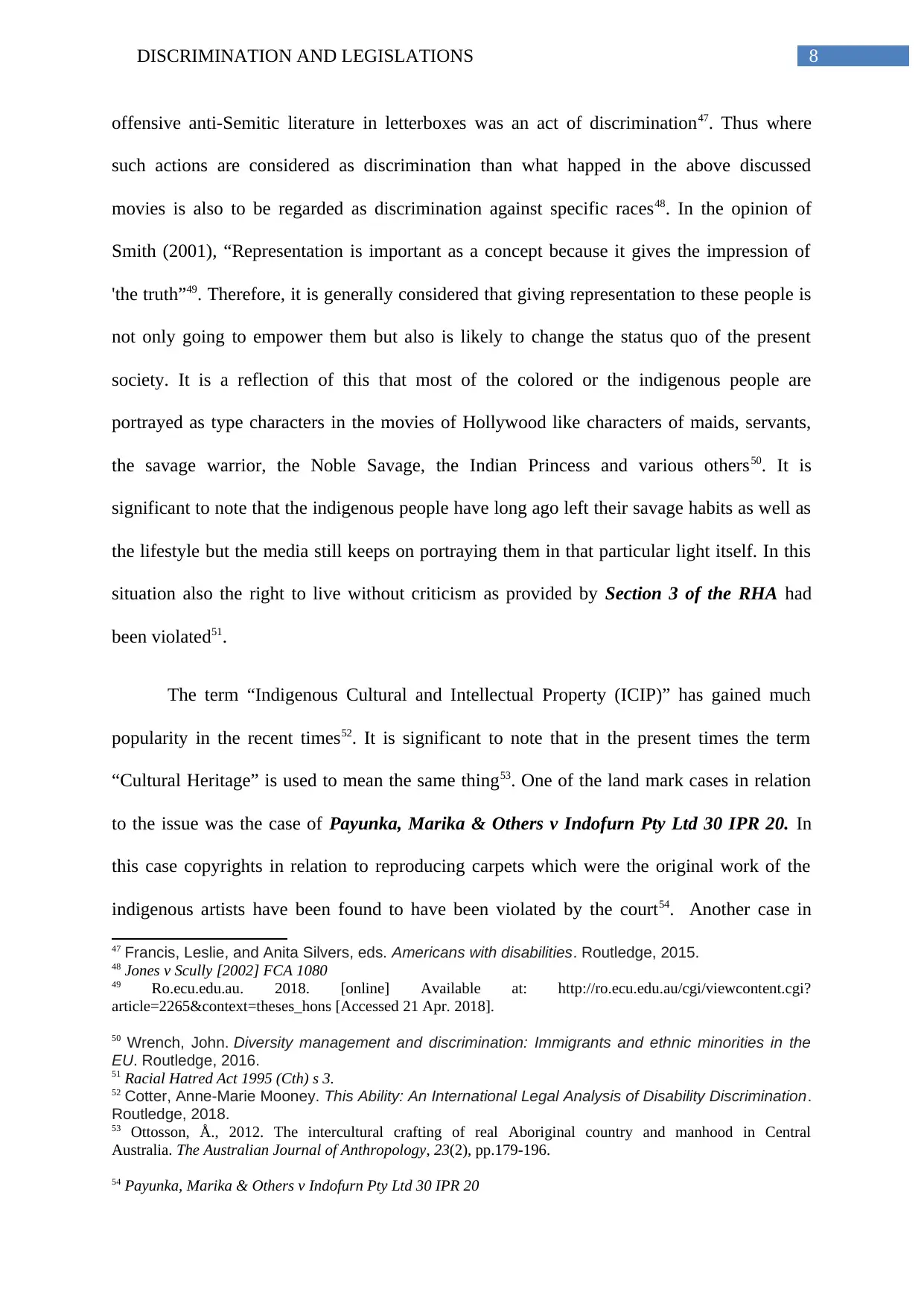
8DISCRIMINATION AND LEGISLATIONS
offensive anti-Semitic literature in letterboxes was an act of discrimination47. Thus where
such actions are considered as discrimination than what happed in the above discussed
movies is also to be regarded as discrimination against specific races48. In the opinion of
Smith (2001), “Representation is important as a concept because it gives the impression of
'the truth”49. Therefore, it is generally considered that giving representation to these people is
not only going to empower them but also is likely to change the status quo of the present
society. It is a reflection of this that most of the colored or the indigenous people are
portrayed as type characters in the movies of Hollywood like characters of maids, servants,
the savage warrior, the Noble Savage, the Indian Princess and various others50. It is
significant to note that the indigenous people have long ago left their savage habits as well as
the lifestyle but the media still keeps on portraying them in that particular light itself. In this
situation also the right to live without criticism as provided by Section 3 of the RHA had
been violated51.
The term “Indigenous Cultural and Intellectual Property (ICIP)” has gained much
popularity in the recent times52. It is significant to note that in the present times the term
“Cultural Heritage” is used to mean the same thing53. One of the land mark cases in relation
to the issue was the case of Payunka, Marika & Others v Indofurn Pty Ltd 30 IPR 20. In
this case copyrights in relation to reproducing carpets which were the original work of the
indigenous artists have been found to have been violated by the court54. Another case in
47 Francis, Leslie, and Anita Silvers, eds. Americans with disabilities. Routledge, 2015.
48 Jones v Scully [2002] FCA 1080
49 Ro.ecu.edu.au. 2018. [online] Available at: http://ro.ecu.edu.au/cgi/viewcontent.cgi?
article=2265&context=theses_hons [Accessed 21 Apr. 2018].
50 Wrench, John. Diversity management and discrimination: Immigrants and ethnic minorities in the
EU. Routledge, 2016.
51 Racial Hatred Act 1995 (Cth) s 3.
52 Cotter, Anne-Marie Mooney. This Ability: An International Legal Analysis of Disability Discrimination.
Routledge, 2018.
53 Ottosson, Å., 2012. The intercultural crafting of real Aboriginal country and manhood in Central
Australia. The Australian Journal of Anthropology, 23(2), pp.179-196.
54 Payunka, Marika & Others v Indofurn Pty Ltd 30 IPR 20
offensive anti-Semitic literature in letterboxes was an act of discrimination47. Thus where
such actions are considered as discrimination than what happed in the above discussed
movies is also to be regarded as discrimination against specific races48. In the opinion of
Smith (2001), “Representation is important as a concept because it gives the impression of
'the truth”49. Therefore, it is generally considered that giving representation to these people is
not only going to empower them but also is likely to change the status quo of the present
society. It is a reflection of this that most of the colored or the indigenous people are
portrayed as type characters in the movies of Hollywood like characters of maids, servants,
the savage warrior, the Noble Savage, the Indian Princess and various others50. It is
significant to note that the indigenous people have long ago left their savage habits as well as
the lifestyle but the media still keeps on portraying them in that particular light itself. In this
situation also the right to live without criticism as provided by Section 3 of the RHA had
been violated51.
The term “Indigenous Cultural and Intellectual Property (ICIP)” has gained much
popularity in the recent times52. It is significant to note that in the present times the term
“Cultural Heritage” is used to mean the same thing53. One of the land mark cases in relation
to the issue was the case of Payunka, Marika & Others v Indofurn Pty Ltd 30 IPR 20. In
this case copyrights in relation to reproducing carpets which were the original work of the
indigenous artists have been found to have been violated by the court54. Another case in
47 Francis, Leslie, and Anita Silvers, eds. Americans with disabilities. Routledge, 2015.
48 Jones v Scully [2002] FCA 1080
49 Ro.ecu.edu.au. 2018. [online] Available at: http://ro.ecu.edu.au/cgi/viewcontent.cgi?
article=2265&context=theses_hons [Accessed 21 Apr. 2018].
50 Wrench, John. Diversity management and discrimination: Immigrants and ethnic minorities in the
EU. Routledge, 2016.
51 Racial Hatred Act 1995 (Cth) s 3.
52 Cotter, Anne-Marie Mooney. This Ability: An International Legal Analysis of Disability Discrimination.
Routledge, 2018.
53 Ottosson, Å., 2012. The intercultural crafting of real Aboriginal country and manhood in Central
Australia. The Australian Journal of Anthropology, 23(2), pp.179-196.
54 Payunka, Marika & Others v Indofurn Pty Ltd 30 IPR 20

9DISCRIMINATION AND LEGISLATIONS
relation to the case is the case of Bulun Bulun, John & Anor v R & T Textiles Pty Ltd -
[1998] FCA 1082 where the concept had been discussed in details55. The court ruled in this
case that the concept of ICIP refers to “all the rights that Indigenous people have, and want to
have, to protect their traditional arts and culture”56. In the recent times because of the kinds of
subversion the indigenous people have received this particular concept has gained
prominence57. The concept of ICIP covers the basic precepts of “Right to protect traditional
knowledge and sacred cultural material, Right to ensure that traditional laws and customary
obligations are respected, particularly when money is made from ICIP, Right to be paid for
use of ICIP, particularly if it has been used in a way which is inconsistent with traditional
laws or without the community's permission” and others58. It is significant to note that the
concept of ICIP is related not only to the writing of the books, poems but other forms of
artistic creation like the production of movies, paintings and others. Therefore, to protect the
rights as well as the artistic creations of the indigenous people and other kinds of colored
people the nation of Australia have came up with various laws like the “Copyright Act 1968
(Cth)”59, which seeks to protect the artistic works composed by the indigenous people, the
“Moral rights of individual artists”, “Individual performer's rights”, “Designs Act 2003
(Cth)”, which aims to protect the various designs created by the indigenous people, “Patents
Act 1990 (Cth)”, which aims to provide patent rights to the indigenous people and others60.
Furthermore, the recent High Court cases in the country of Australia like “Western Australia
55 Bulun Bulun, John & Anor v R & T Textiles Pty Ltd - [1998] FCA 1082
56 Artslaw.com.au. 2018. [online] Available at:
https://www.artslaw.com.au/images/uploads/aitb/AITB_information_sheet_-
_Indigenous_cultural_and_intellectual_property_ICIP_2.pdf [Accessed 21 Apr. 2018].
57 Culturalsurvival.org. 2018. Protecting Indigenous Intellectual Property Rights: Tools That Work. [online]
Available at: https://www.culturalsurvival.org/publications/cultural-survival-quarterly/protecting-indigenous-
intellectual-property-rights-tools [Accessed 21 Apr. 2018].
58 Yamada, David C. "Workplace bullying and the law: US legislative developments 2013-15." Emp.
Rts. & Emp. Pol'y J.19 (2015): 49.
59 Copyright Act 1968 (Cth)
60 Patents Act 1990 (Cth)
relation to the case is the case of Bulun Bulun, John & Anor v R & T Textiles Pty Ltd -
[1998] FCA 1082 where the concept had been discussed in details55. The court ruled in this
case that the concept of ICIP refers to “all the rights that Indigenous people have, and want to
have, to protect their traditional arts and culture”56. In the recent times because of the kinds of
subversion the indigenous people have received this particular concept has gained
prominence57. The concept of ICIP covers the basic precepts of “Right to protect traditional
knowledge and sacred cultural material, Right to ensure that traditional laws and customary
obligations are respected, particularly when money is made from ICIP, Right to be paid for
use of ICIP, particularly if it has been used in a way which is inconsistent with traditional
laws or without the community's permission” and others58. It is significant to note that the
concept of ICIP is related not only to the writing of the books, poems but other forms of
artistic creation like the production of movies, paintings and others. Therefore, to protect the
rights as well as the artistic creations of the indigenous people and other kinds of colored
people the nation of Australia have came up with various laws like the “Copyright Act 1968
(Cth)”59, which seeks to protect the artistic works composed by the indigenous people, the
“Moral rights of individual artists”, “Individual performer's rights”, “Designs Act 2003
(Cth)”, which aims to protect the various designs created by the indigenous people, “Patents
Act 1990 (Cth)”, which aims to provide patent rights to the indigenous people and others60.
Furthermore, the recent High Court cases in the country of Australia like “Western Australia
55 Bulun Bulun, John & Anor v R & T Textiles Pty Ltd - [1998] FCA 1082
56 Artslaw.com.au. 2018. [online] Available at:
https://www.artslaw.com.au/images/uploads/aitb/AITB_information_sheet_-
_Indigenous_cultural_and_intellectual_property_ICIP_2.pdf [Accessed 21 Apr. 2018].
57 Culturalsurvival.org. 2018. Protecting Indigenous Intellectual Property Rights: Tools That Work. [online]
Available at: https://www.culturalsurvival.org/publications/cultural-survival-quarterly/protecting-indigenous-
intellectual-property-rights-tools [Accessed 21 Apr. 2018].
58 Yamada, David C. "Workplace bullying and the law: US legislative developments 2013-15." Emp.
Rts. & Emp. Pol'y J.19 (2015): 49.
59 Copyright Act 1968 (Cth)
60 Patents Act 1990 (Cth)
Secure Best Marks with AI Grader
Need help grading? Try our AI Grader for instant feedback on your assignments.
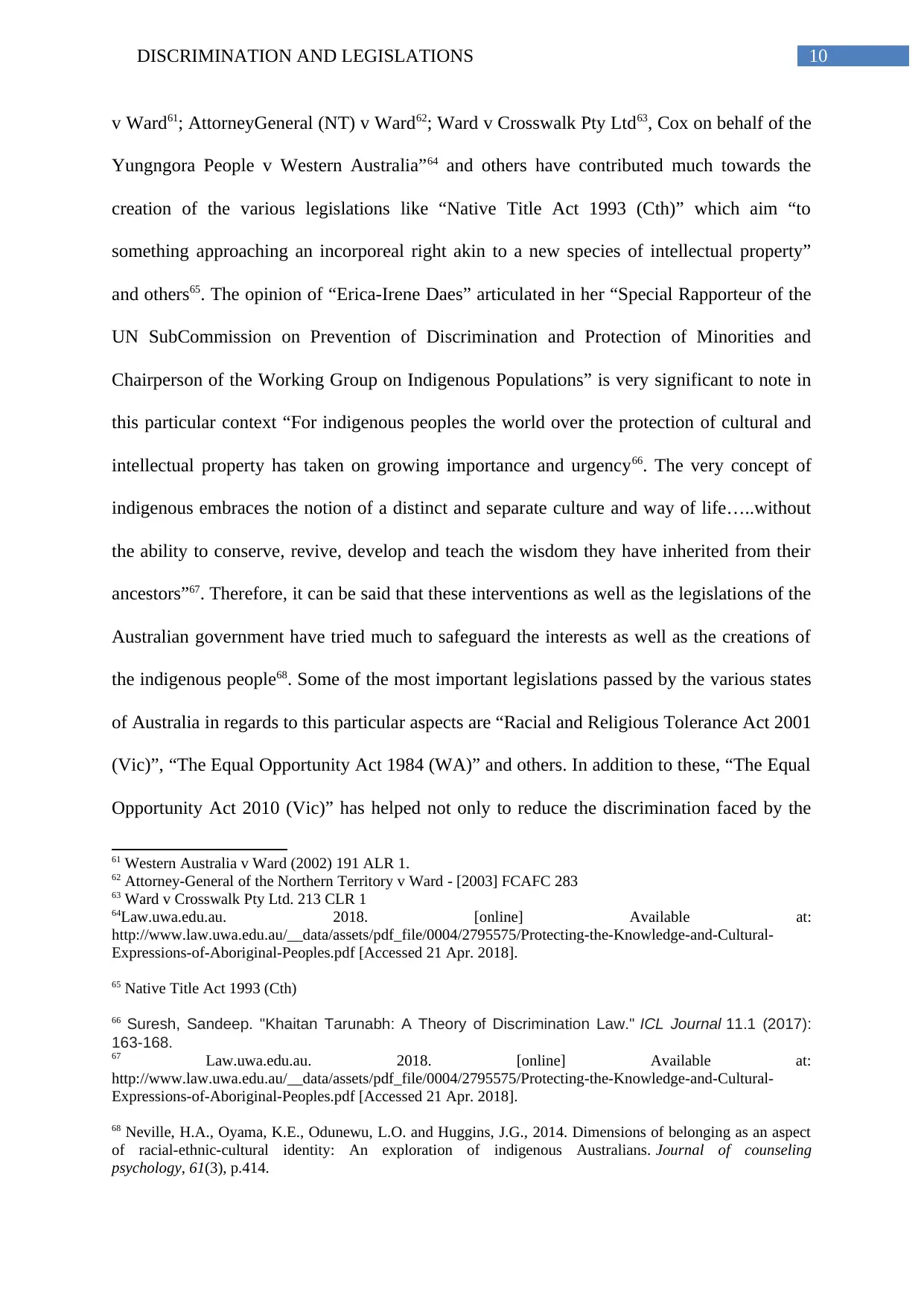
10DISCRIMINATION AND LEGISLATIONS
v Ward61; AttorneyGeneral (NT) v Ward62; Ward v Crosswalk Pty Ltd63, Cox on behalf of the
Yungngora People v Western Australia”64 and others have contributed much towards the
creation of the various legislations like “Native Title Act 1993 (Cth)” which aim “to
something approaching an incorporeal right akin to a new species of intellectual property”
and others65. The opinion of “Erica-Irene Daes” articulated in her “Special Rapporteur of the
UN SubCommission on Prevention of Discrimination and Protection of Minorities and
Chairperson of the Working Group on Indigenous Populations” is very significant to note in
this particular context “For indigenous peoples the world over the protection of cultural and
intellectual property has taken on growing importance and urgency66. The very concept of
indigenous embraces the notion of a distinct and separate culture and way of life…..without
the ability to conserve, revive, develop and teach the wisdom they have inherited from their
ancestors”67. Therefore, it can be said that these interventions as well as the legislations of the
Australian government have tried much to safeguard the interests as well as the creations of
the indigenous people68. Some of the most important legislations passed by the various states
of Australia in regards to this particular aspects are “Racial and Religious Tolerance Act 2001
(Vic)”, “The Equal Opportunity Act 1984 (WA)” and others. In addition to these, “The Equal
Opportunity Act 2010 (Vic)” has helped not only to reduce the discrimination faced by the
61 Western Australia v Ward (2002) 191 ALR 1.
62 Attorney-General of the Northern Territory v Ward - [2003] FCAFC 283
63 Ward v Crosswalk Pty Ltd. 213 CLR 1
64Law.uwa.edu.au. 2018. [online] Available at:
http://www.law.uwa.edu.au/__data/assets/pdf_file/0004/2795575/Protecting-the-Knowledge-and-Cultural-
Expressions-of-Aboriginal-Peoples.pdf [Accessed 21 Apr. 2018].
65 Native Title Act 1993 (Cth)
66 Suresh, Sandeep. "Khaitan Tarunabh: A Theory of Discrimination Law." ICL Journal 11.1 (2017):
163-168.
67 Law.uwa.edu.au. 2018. [online] Available at:
http://www.law.uwa.edu.au/__data/assets/pdf_file/0004/2795575/Protecting-the-Knowledge-and-Cultural-
Expressions-of-Aboriginal-Peoples.pdf [Accessed 21 Apr. 2018].
68 Neville, H.A., Oyama, K.E., Odunewu, L.O. and Huggins, J.G., 2014. Dimensions of belonging as an aspect
of racial-ethnic-cultural identity: An exploration of indigenous Australians. Journal of counseling
psychology, 61(3), p.414.
v Ward61; AttorneyGeneral (NT) v Ward62; Ward v Crosswalk Pty Ltd63, Cox on behalf of the
Yungngora People v Western Australia”64 and others have contributed much towards the
creation of the various legislations like “Native Title Act 1993 (Cth)” which aim “to
something approaching an incorporeal right akin to a new species of intellectual property”
and others65. The opinion of “Erica-Irene Daes” articulated in her “Special Rapporteur of the
UN SubCommission on Prevention of Discrimination and Protection of Minorities and
Chairperson of the Working Group on Indigenous Populations” is very significant to note in
this particular context “For indigenous peoples the world over the protection of cultural and
intellectual property has taken on growing importance and urgency66. The very concept of
indigenous embraces the notion of a distinct and separate culture and way of life…..without
the ability to conserve, revive, develop and teach the wisdom they have inherited from their
ancestors”67. Therefore, it can be said that these interventions as well as the legislations of the
Australian government have tried much to safeguard the interests as well as the creations of
the indigenous people68. Some of the most important legislations passed by the various states
of Australia in regards to this particular aspects are “Racial and Religious Tolerance Act 2001
(Vic)”, “The Equal Opportunity Act 1984 (WA)” and others. In addition to these, “The Equal
Opportunity Act 2010 (Vic)” has helped not only to reduce the discrimination faced by the
61 Western Australia v Ward (2002) 191 ALR 1.
62 Attorney-General of the Northern Territory v Ward - [2003] FCAFC 283
63 Ward v Crosswalk Pty Ltd. 213 CLR 1
64Law.uwa.edu.au. 2018. [online] Available at:
http://www.law.uwa.edu.au/__data/assets/pdf_file/0004/2795575/Protecting-the-Knowledge-and-Cultural-
Expressions-of-Aboriginal-Peoples.pdf [Accessed 21 Apr. 2018].
65 Native Title Act 1993 (Cth)
66 Suresh, Sandeep. "Khaitan Tarunabh: A Theory of Discrimination Law." ICL Journal 11.1 (2017):
163-168.
67 Law.uwa.edu.au. 2018. [online] Available at:
http://www.law.uwa.edu.au/__data/assets/pdf_file/0004/2795575/Protecting-the-Knowledge-and-Cultural-
Expressions-of-Aboriginal-Peoples.pdf [Accessed 21 Apr. 2018].
68 Neville, H.A., Oyama, K.E., Odunewu, L.O. and Huggins, J.G., 2014. Dimensions of belonging as an aspect
of racial-ethnic-cultural identity: An exploration of indigenous Australians. Journal of counseling
psychology, 61(3), p.414.
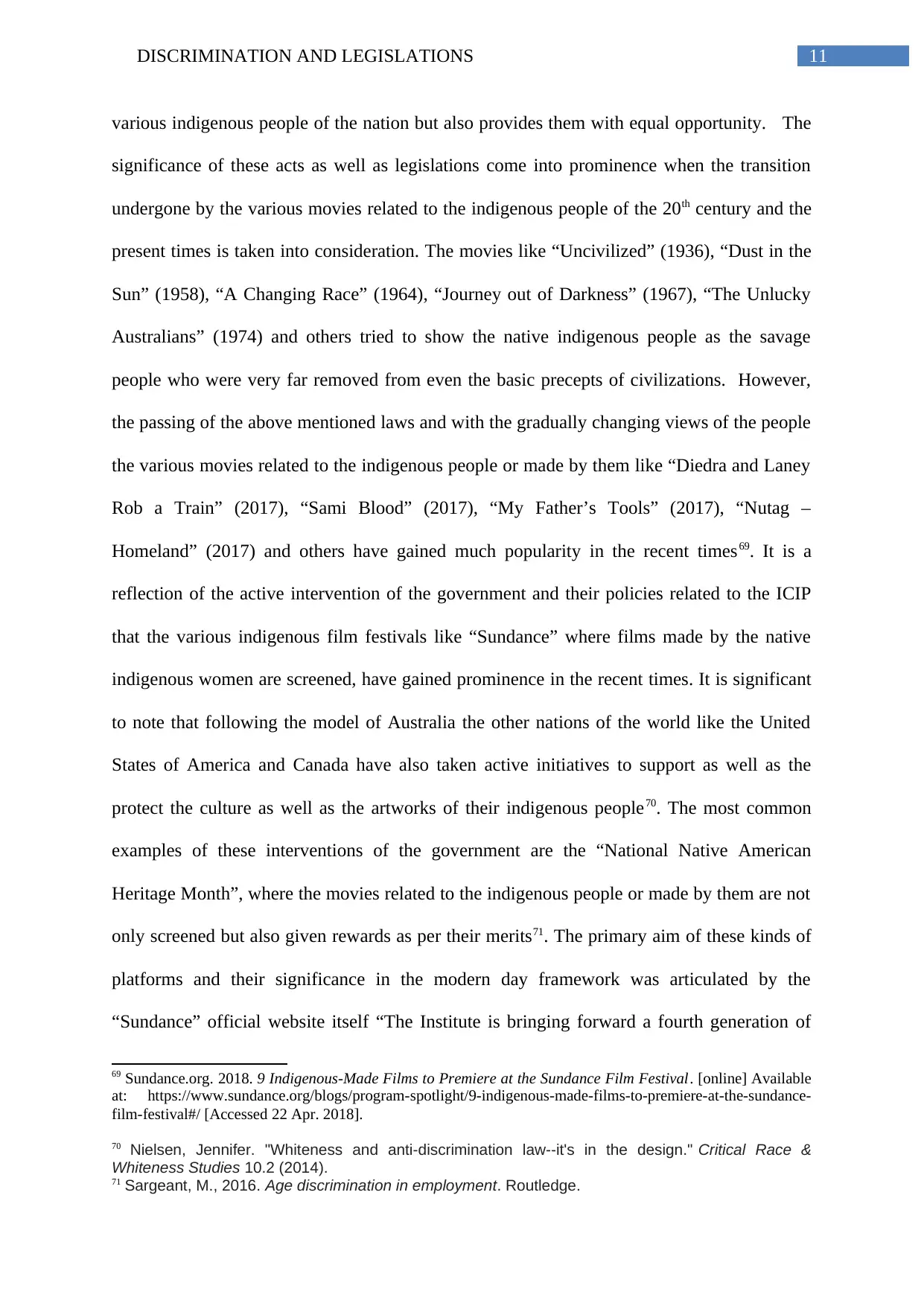
11DISCRIMINATION AND LEGISLATIONS
various indigenous people of the nation but also provides them with equal opportunity. The
significance of these acts as well as legislations come into prominence when the transition
undergone by the various movies related to the indigenous people of the 20th century and the
present times is taken into consideration. The movies like “Uncivilized” (1936), “Dust in the
Sun” (1958), “A Changing Race” (1964), “Journey out of Darkness” (1967), “The Unlucky
Australians” (1974) and others tried to show the native indigenous people as the savage
people who were very far removed from even the basic precepts of civilizations. However,
the passing of the above mentioned laws and with the gradually changing views of the people
the various movies related to the indigenous people or made by them like “Diedra and Laney
Rob a Train” (2017), “Sami Blood” (2017), “My Father’s Tools” (2017), “Nutag –
Homeland” (2017) and others have gained much popularity in the recent times69. It is a
reflection of the active intervention of the government and their policies related to the ICIP
that the various indigenous film festivals like “Sundance” where films made by the native
indigenous women are screened, have gained prominence in the recent times. It is significant
to note that following the model of Australia the other nations of the world like the United
States of America and Canada have also taken active initiatives to support as well as the
protect the culture as well as the artworks of their indigenous people70. The most common
examples of these interventions of the government are the “National Native American
Heritage Month”, where the movies related to the indigenous people or made by them are not
only screened but also given rewards as per their merits71. The primary aim of these kinds of
platforms and their significance in the modern day framework was articulated by the
“Sundance” official website itself “The Institute is bringing forward a fourth generation of
69 Sundance.org. 2018. 9 Indigenous-Made Films to Premiere at the Sundance Film Festival. [online] Available
at: https://www.sundance.org/blogs/program-spotlight/9-indigenous-made-films-to-premiere-at-the-sundance-
film-festival#/ [Accessed 22 Apr. 2018].
70 Nielsen, Jennifer. "Whiteness and anti-discrimination law--it's in the design." Critical Race &
Whiteness Studies 10.2 (2014).
71 Sargeant, M., 2016. Age discrimination in employment. Routledge.
various indigenous people of the nation but also provides them with equal opportunity. The
significance of these acts as well as legislations come into prominence when the transition
undergone by the various movies related to the indigenous people of the 20th century and the
present times is taken into consideration. The movies like “Uncivilized” (1936), “Dust in the
Sun” (1958), “A Changing Race” (1964), “Journey out of Darkness” (1967), “The Unlucky
Australians” (1974) and others tried to show the native indigenous people as the savage
people who were very far removed from even the basic precepts of civilizations. However,
the passing of the above mentioned laws and with the gradually changing views of the people
the various movies related to the indigenous people or made by them like “Diedra and Laney
Rob a Train” (2017), “Sami Blood” (2017), “My Father’s Tools” (2017), “Nutag –
Homeland” (2017) and others have gained much popularity in the recent times69. It is a
reflection of the active intervention of the government and their policies related to the ICIP
that the various indigenous film festivals like “Sundance” where films made by the native
indigenous women are screened, have gained prominence in the recent times. It is significant
to note that following the model of Australia the other nations of the world like the United
States of America and Canada have also taken active initiatives to support as well as the
protect the culture as well as the artworks of their indigenous people70. The most common
examples of these interventions of the government are the “National Native American
Heritage Month”, where the movies related to the indigenous people or made by them are not
only screened but also given rewards as per their merits71. The primary aim of these kinds of
platforms and their significance in the modern day framework was articulated by the
“Sundance” official website itself “The Institute is bringing forward a fourth generation of
69 Sundance.org. 2018. 9 Indigenous-Made Films to Premiere at the Sundance Film Festival. [online] Available
at: https://www.sundance.org/blogs/program-spotlight/9-indigenous-made-films-to-premiere-at-the-sundance-
film-festival#/ [Accessed 22 Apr. 2018].
70 Nielsen, Jennifer. "Whiteness and anti-discrimination law--it's in the design." Critical Race &
Whiteness Studies 10.2 (2014).
71 Sargeant, M., 2016. Age discrimination in employment. Routledge.
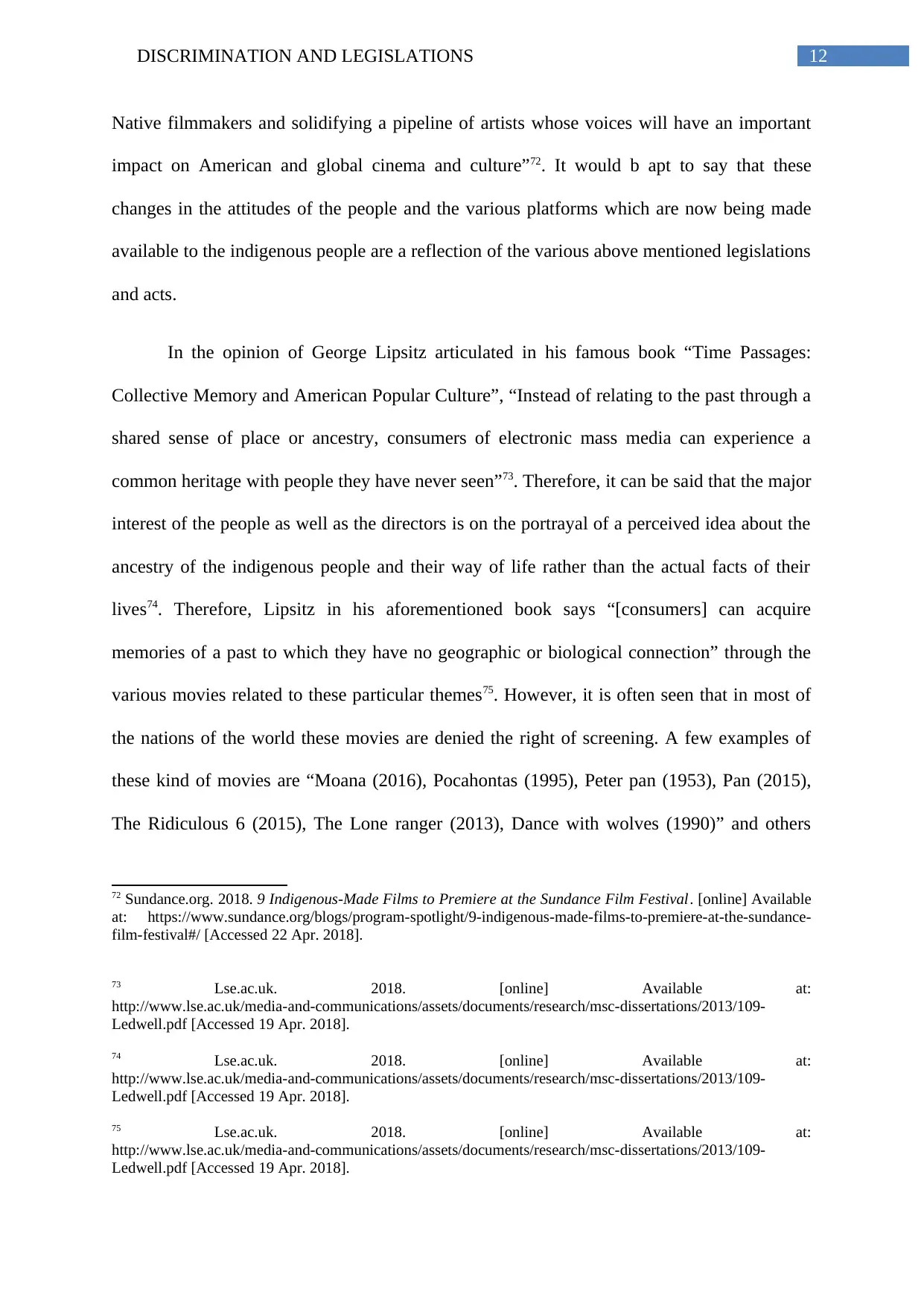
12DISCRIMINATION AND LEGISLATIONS
Native filmmakers and solidifying a pipeline of artists whose voices will have an important
impact on American and global cinema and culture”72. It would b apt to say that these
changes in the attitudes of the people and the various platforms which are now being made
available to the indigenous people are a reflection of the various above mentioned legislations
and acts.
In the opinion of George Lipsitz articulated in his famous book “Time Passages:
Collective Memory and American Popular Culture”, “Instead of relating to the past through a
shared sense of place or ancestry, consumers of electronic mass media can experience a
common heritage with people they have never seen”73. Therefore, it can be said that the major
interest of the people as well as the directors is on the portrayal of a perceived idea about the
ancestry of the indigenous people and their way of life rather than the actual facts of their
lives74. Therefore, Lipsitz in his aforementioned book says “[consumers] can acquire
memories of a past to which they have no geographic or biological connection” through the
various movies related to these particular themes75. However, it is often seen that in most of
the nations of the world these movies are denied the right of screening. A few examples of
these kind of movies are “Moana (2016), Pocahontas (1995), Peter pan (1953), Pan (2015),
The Ridiculous 6 (2015), The Lone ranger (2013), Dance with wolves (1990)” and others
72 Sundance.org. 2018. 9 Indigenous-Made Films to Premiere at the Sundance Film Festival. [online] Available
at: https://www.sundance.org/blogs/program-spotlight/9-indigenous-made-films-to-premiere-at-the-sundance-
film-festival#/ [Accessed 22 Apr. 2018].
73 Lse.ac.uk. 2018. [online] Available at:
http://www.lse.ac.uk/media-and-communications/assets/documents/research/msc-dissertations/2013/109-
Ledwell.pdf [Accessed 19 Apr. 2018].
74 Lse.ac.uk. 2018. [online] Available at:
http://www.lse.ac.uk/media-and-communications/assets/documents/research/msc-dissertations/2013/109-
Ledwell.pdf [Accessed 19 Apr. 2018].
75 Lse.ac.uk. 2018. [online] Available at:
http://www.lse.ac.uk/media-and-communications/assets/documents/research/msc-dissertations/2013/109-
Ledwell.pdf [Accessed 19 Apr. 2018].
Native filmmakers and solidifying a pipeline of artists whose voices will have an important
impact on American and global cinema and culture”72. It would b apt to say that these
changes in the attitudes of the people and the various platforms which are now being made
available to the indigenous people are a reflection of the various above mentioned legislations
and acts.
In the opinion of George Lipsitz articulated in his famous book “Time Passages:
Collective Memory and American Popular Culture”, “Instead of relating to the past through a
shared sense of place or ancestry, consumers of electronic mass media can experience a
common heritage with people they have never seen”73. Therefore, it can be said that the major
interest of the people as well as the directors is on the portrayal of a perceived idea about the
ancestry of the indigenous people and their way of life rather than the actual facts of their
lives74. Therefore, Lipsitz in his aforementioned book says “[consumers] can acquire
memories of a past to which they have no geographic or biological connection” through the
various movies related to these particular themes75. However, it is often seen that in most of
the nations of the world these movies are denied the right of screening. A few examples of
these kind of movies are “Moana (2016), Pocahontas (1995), Peter pan (1953), Pan (2015),
The Ridiculous 6 (2015), The Lone ranger (2013), Dance with wolves (1990)” and others
72 Sundance.org. 2018. 9 Indigenous-Made Films to Premiere at the Sundance Film Festival. [online] Available
at: https://www.sundance.org/blogs/program-spotlight/9-indigenous-made-films-to-premiere-at-the-sundance-
film-festival#/ [Accessed 22 Apr. 2018].
73 Lse.ac.uk. 2018. [online] Available at:
http://www.lse.ac.uk/media-and-communications/assets/documents/research/msc-dissertations/2013/109-
Ledwell.pdf [Accessed 19 Apr. 2018].
74 Lse.ac.uk. 2018. [online] Available at:
http://www.lse.ac.uk/media-and-communications/assets/documents/research/msc-dissertations/2013/109-
Ledwell.pdf [Accessed 19 Apr. 2018].
75 Lse.ac.uk. 2018. [online] Available at:
http://www.lse.ac.uk/media-and-communications/assets/documents/research/msc-dissertations/2013/109-
Ledwell.pdf [Accessed 19 Apr. 2018].
Paraphrase This Document
Need a fresh take? Get an instant paraphrase of this document with our AI Paraphraser
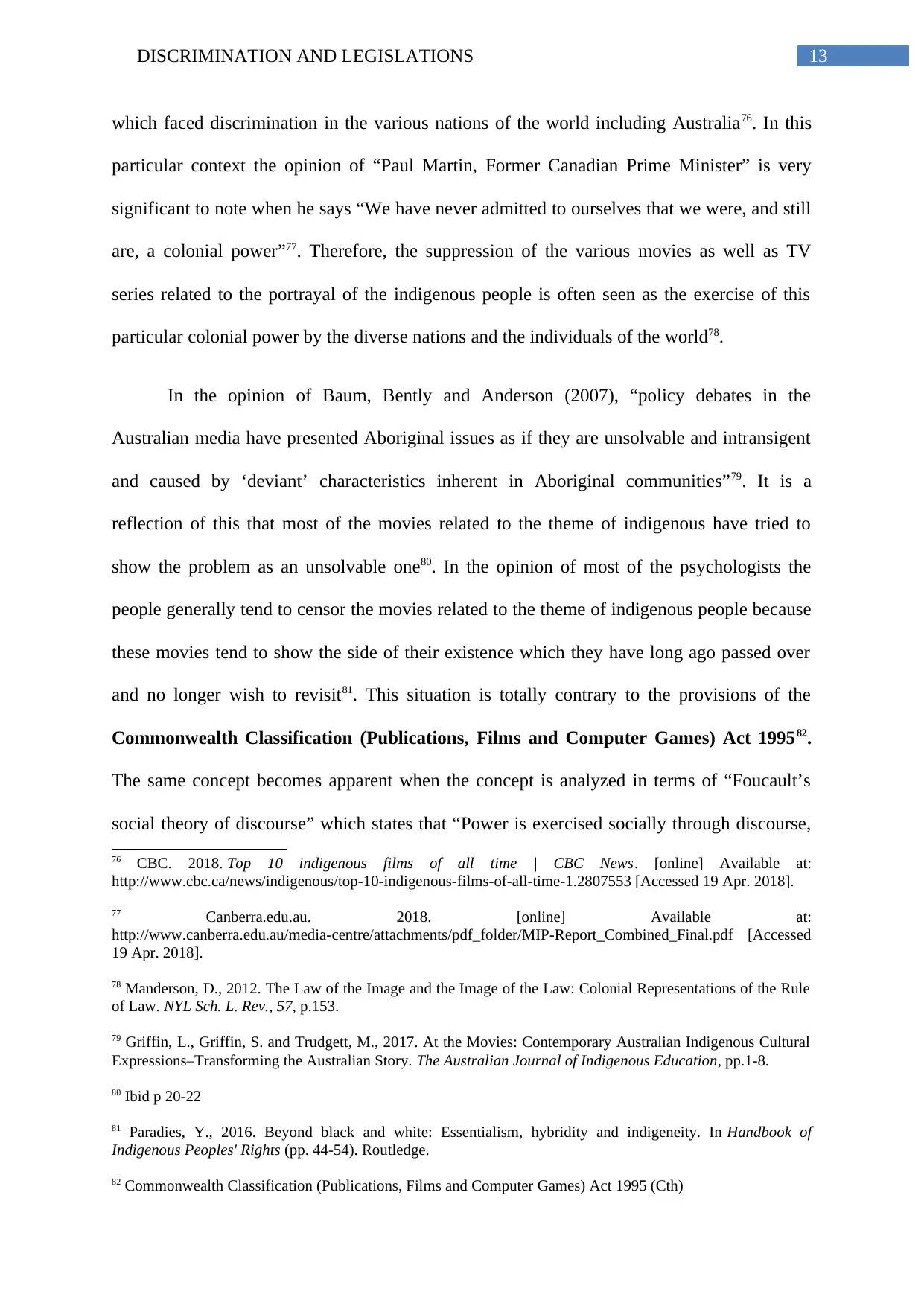
13DISCRIMINATION AND LEGISLATIONS
which faced discrimination in the various nations of the world including Australia76. In this
particular context the opinion of “Paul Martin, Former Canadian Prime Minister” is very
significant to note when he says “We have never admitted to ourselves that we were, and still
are, a colonial power”77. Therefore, the suppression of the various movies as well as TV
series related to the portrayal of the indigenous people is often seen as the exercise of this
particular colonial power by the diverse nations and the individuals of the world78.
In the opinion of Baum, Bently and Anderson (2007), “policy debates in the
Australian media have presented Aboriginal issues as if they are unsolvable and intransigent
and caused by ‘deviant’ characteristics inherent in Aboriginal communities”79. It is a
reflection of this that most of the movies related to the theme of indigenous have tried to
show the problem as an unsolvable one80. In the opinion of most of the psychologists the
people generally tend to censor the movies related to the theme of indigenous people because
these movies tend to show the side of their existence which they have long ago passed over
and no longer wish to revisit81. This situation is totally contrary to the provisions of the
Commonwealth Classification (Publications, Films and Computer Games) Act 199582.
The same concept becomes apparent when the concept is analyzed in terms of “Foucault’s
social theory of discourse” which states that “Power is exercised socially through discourse,
76 CBC. 2018. Top 10 indigenous films of all time | CBC News. [online] Available at:
http://www.cbc.ca/news/indigenous/top-10-indigenous-films-of-all-time-1.2807553 [Accessed 19 Apr. 2018].
77 Canberra.edu.au. 2018. [online] Available at:
http://www.canberra.edu.au/media-centre/attachments/pdf_folder/MIP-Report_Combined_Final.pdf [Accessed
19 Apr. 2018].
78 Manderson, D., 2012. The Law of the Image and the Image of the Law: Colonial Representations of the Rule
of Law. NYL Sch. L. Rev., 57, p.153.
79 Griffin, L., Griffin, S. and Trudgett, M., 2017. At the Movies: Contemporary Australian Indigenous Cultural
Expressions–Transforming the Australian Story. The Australian Journal of Indigenous Education, pp.1-8.
80 Ibid p 20-22
81 Paradies, Y., 2016. Beyond black and white: Essentialism, hybridity and indigeneity. In Handbook of
Indigenous Peoples' Rights (pp. 44-54). Routledge.
82 Commonwealth Classification (Publications, Films and Computer Games) Act 1995 (Cth)
which faced discrimination in the various nations of the world including Australia76. In this
particular context the opinion of “Paul Martin, Former Canadian Prime Minister” is very
significant to note when he says “We have never admitted to ourselves that we were, and still
are, a colonial power”77. Therefore, the suppression of the various movies as well as TV
series related to the portrayal of the indigenous people is often seen as the exercise of this
particular colonial power by the diverse nations and the individuals of the world78.
In the opinion of Baum, Bently and Anderson (2007), “policy debates in the
Australian media have presented Aboriginal issues as if they are unsolvable and intransigent
and caused by ‘deviant’ characteristics inherent in Aboriginal communities”79. It is a
reflection of this that most of the movies related to the theme of indigenous have tried to
show the problem as an unsolvable one80. In the opinion of most of the psychologists the
people generally tend to censor the movies related to the theme of indigenous people because
these movies tend to show the side of their existence which they have long ago passed over
and no longer wish to revisit81. This situation is totally contrary to the provisions of the
Commonwealth Classification (Publications, Films and Computer Games) Act 199582.
The same concept becomes apparent when the concept is analyzed in terms of “Foucault’s
social theory of discourse” which states that “Power is exercised socially through discourse,
76 CBC. 2018. Top 10 indigenous films of all time | CBC News. [online] Available at:
http://www.cbc.ca/news/indigenous/top-10-indigenous-films-of-all-time-1.2807553 [Accessed 19 Apr. 2018].
77 Canberra.edu.au. 2018. [online] Available at:
http://www.canberra.edu.au/media-centre/attachments/pdf_folder/MIP-Report_Combined_Final.pdf [Accessed
19 Apr. 2018].
78 Manderson, D., 2012. The Law of the Image and the Image of the Law: Colonial Representations of the Rule
of Law. NYL Sch. L. Rev., 57, p.153.
79 Griffin, L., Griffin, S. and Trudgett, M., 2017. At the Movies: Contemporary Australian Indigenous Cultural
Expressions–Transforming the Australian Story. The Australian Journal of Indigenous Education, pp.1-8.
80 Ibid p 20-22
81 Paradies, Y., 2016. Beyond black and white: Essentialism, hybridity and indigeneity. In Handbook of
Indigenous Peoples' Rights (pp. 44-54). Routledge.
82 Commonwealth Classification (Publications, Films and Computer Games) Act 1995 (Cth)
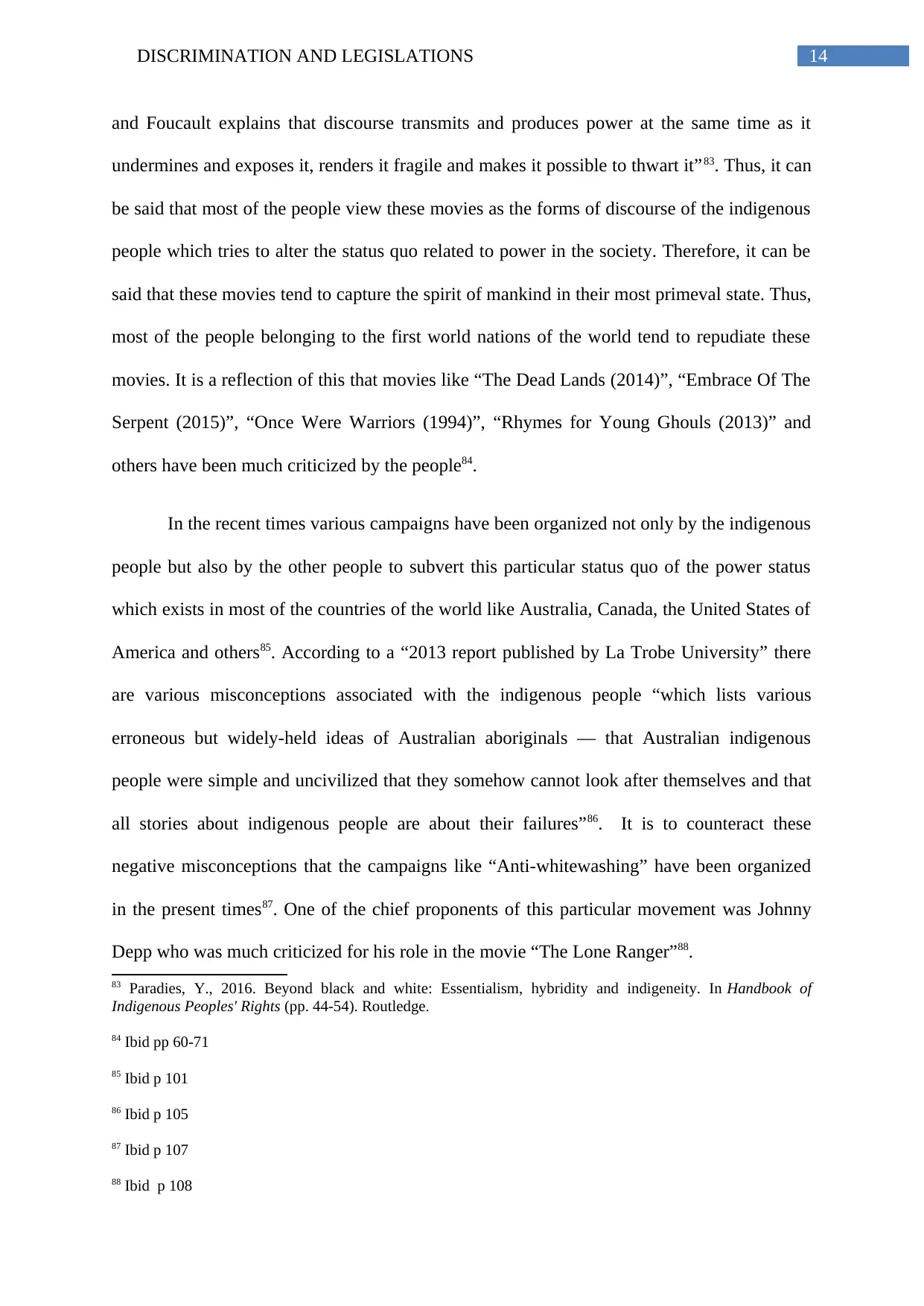
14DISCRIMINATION AND LEGISLATIONS
and Foucault explains that discourse transmits and produces power at the same time as it
undermines and exposes it, renders it fragile and makes it possible to thwart it”83. Thus, it can
be said that most of the people view these movies as the forms of discourse of the indigenous
people which tries to alter the status quo related to power in the society. Therefore, it can be
said that these movies tend to capture the spirit of mankind in their most primeval state. Thus,
most of the people belonging to the first world nations of the world tend to repudiate these
movies. It is a reflection of this that movies like “The Dead Lands (2014)”, “Embrace Of The
Serpent (2015)”, “Once Were Warriors (1994)”, “Rhymes for Young Ghouls (2013)” and
others have been much criticized by the people84.
In the recent times various campaigns have been organized not only by the indigenous
people but also by the other people to subvert this particular status quo of the power status
which exists in most of the countries of the world like Australia, Canada, the United States of
America and others85. According to a “2013 report published by La Trobe University” there
are various misconceptions associated with the indigenous people “which lists various
erroneous but widely-held ideas of Australian aboriginals — that Australian indigenous
people were simple and uncivilized that they somehow cannot look after themselves and that
all stories about indigenous people are about their failures”86. It is to counteract these
negative misconceptions that the campaigns like “Anti-whitewashing” have been organized
in the present times87. One of the chief proponents of this particular movement was Johnny
Depp who was much criticized for his role in the movie “The Lone Ranger”88.
83 Paradies, Y., 2016. Beyond black and white: Essentialism, hybridity and indigeneity. In Handbook of
Indigenous Peoples' Rights (pp. 44-54). Routledge.
84 Ibid pp 60-71
85 Ibid p 101
86 Ibid p 105
87 Ibid p 107
88 Ibid p 108
and Foucault explains that discourse transmits and produces power at the same time as it
undermines and exposes it, renders it fragile and makes it possible to thwart it”83. Thus, it can
be said that most of the people view these movies as the forms of discourse of the indigenous
people which tries to alter the status quo related to power in the society. Therefore, it can be
said that these movies tend to capture the spirit of mankind in their most primeval state. Thus,
most of the people belonging to the first world nations of the world tend to repudiate these
movies. It is a reflection of this that movies like “The Dead Lands (2014)”, “Embrace Of The
Serpent (2015)”, “Once Were Warriors (1994)”, “Rhymes for Young Ghouls (2013)” and
others have been much criticized by the people84.
In the recent times various campaigns have been organized not only by the indigenous
people but also by the other people to subvert this particular status quo of the power status
which exists in most of the countries of the world like Australia, Canada, the United States of
America and others85. According to a “2013 report published by La Trobe University” there
are various misconceptions associated with the indigenous people “which lists various
erroneous but widely-held ideas of Australian aboriginals — that Australian indigenous
people were simple and uncivilized that they somehow cannot look after themselves and that
all stories about indigenous people are about their failures”86. It is to counteract these
negative misconceptions that the campaigns like “Anti-whitewashing” have been organized
in the present times87. One of the chief proponents of this particular movement was Johnny
Depp who was much criticized for his role in the movie “The Lone Ranger”88.
83 Paradies, Y., 2016. Beyond black and white: Essentialism, hybridity and indigeneity. In Handbook of
Indigenous Peoples' Rights (pp. 44-54). Routledge.
84 Ibid pp 60-71
85 Ibid p 101
86 Ibid p 105
87 Ibid p 107
88 Ibid p 108

15DISCRIMINATION AND LEGISLATIONS
In most of the movies in which the colored and the other indigenous people find
representation it is commonly seen that there are certain ways in which the reality of the lives
of these people is subtly subverted89. The most commonly used techniques are whitewashing,
race-blending and others90. The most common example of the incident of whitewashing is the
“2015, Joe Wright's Pan” where “Rooney Mara as the movie's Indian princess Tiger Lily”.
Another significant fact to note that in the movies where the colored or the indigenous people
find representation it is generally seen that in the course of the movie there are some white
saviors who emerge at various critical points to relive the indigenous or the colored people of
their distress91. It has been provided through the provisions of Section 8 of the ANTI-
DISCRIMINATION ACT 1977 that no person should indulge in discrimination against a
person based on race where such person is an applicant or an employee92. Providing the rule
to people of other races depicts the level of discrimination which takes place in the
Hollywood industry. Another common feature all these movies is the fact of blending of the
races or the emergence of a new kind of race which is a fusion between the pure white and
the colored or the indigenous people and is considered to be superior than the pure colored or
the indigenous and inferior to the pure white people93. It is a reflection of this the American
movie “The Lone Ranger” (2013) in which Johnny Depp played the lead role of an
indigenous person was much criticized for it.
The concept of “Intellectual Property” can be defined as the “a category of property
that includes intangible creations of the human intellect, and primarily encompasses
89 Ibid p 110
90 Ibid p 119
91 Ibid p 121
92 ANTI-DISCRIMINATION ACT 1977 (Cth) s 8
93 Christie, M. and Verran, H., 2013. Digital lives in postcolonial Aboriginal Australia. Journal of Material
Culture, 18(3), pp.299-317.
In most of the movies in which the colored and the other indigenous people find
representation it is commonly seen that there are certain ways in which the reality of the lives
of these people is subtly subverted89. The most commonly used techniques are whitewashing,
race-blending and others90. The most common example of the incident of whitewashing is the
“2015, Joe Wright's Pan” where “Rooney Mara as the movie's Indian princess Tiger Lily”.
Another significant fact to note that in the movies where the colored or the indigenous people
find representation it is generally seen that in the course of the movie there are some white
saviors who emerge at various critical points to relive the indigenous or the colored people of
their distress91. It has been provided through the provisions of Section 8 of the ANTI-
DISCRIMINATION ACT 1977 that no person should indulge in discrimination against a
person based on race where such person is an applicant or an employee92. Providing the rule
to people of other races depicts the level of discrimination which takes place in the
Hollywood industry. Another common feature all these movies is the fact of blending of the
races or the emergence of a new kind of race which is a fusion between the pure white and
the colored or the indigenous people and is considered to be superior than the pure colored or
the indigenous and inferior to the pure white people93. It is a reflection of this the American
movie “The Lone Ranger” (2013) in which Johnny Depp played the lead role of an
indigenous person was much criticized for it.
The concept of “Intellectual Property” can be defined as the “a category of property
that includes intangible creations of the human intellect, and primarily encompasses
89 Ibid p 110
90 Ibid p 119
91 Ibid p 121
92 ANTI-DISCRIMINATION ACT 1977 (Cth) s 8
93 Christie, M. and Verran, H., 2013. Digital lives in postcolonial Aboriginal Australia. Journal of Material
Culture, 18(3), pp.299-317.
Secure Best Marks with AI Grader
Need help grading? Try our AI Grader for instant feedback on your assignments.
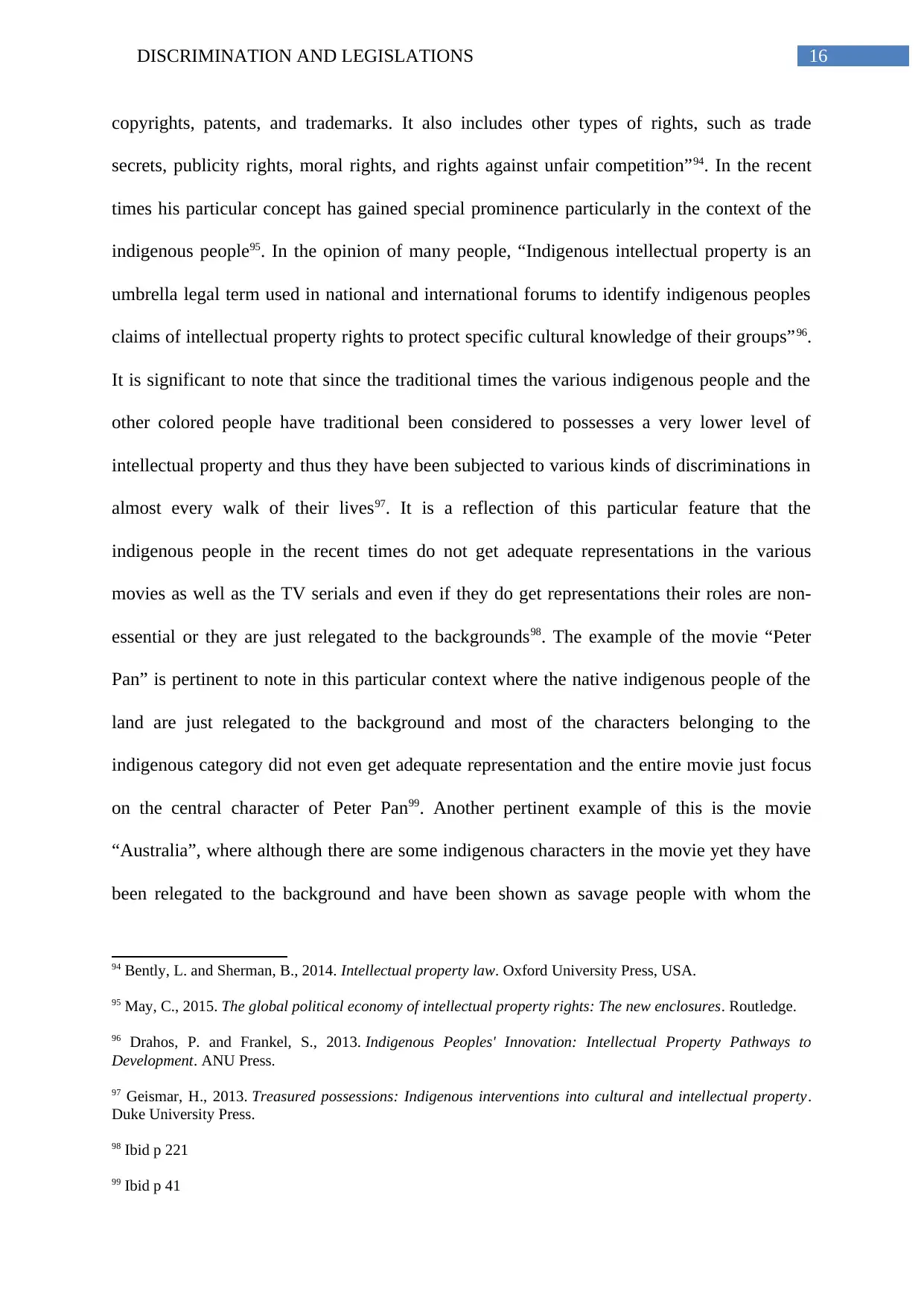
16DISCRIMINATION AND LEGISLATIONS
copyrights, patents, and trademarks. It also includes other types of rights, such as trade
secrets, publicity rights, moral rights, and rights against unfair competition”94. In the recent
times his particular concept has gained special prominence particularly in the context of the
indigenous people95. In the opinion of many people, “Indigenous intellectual property is an
umbrella legal term used in national and international forums to identify indigenous peoples
claims of intellectual property rights to protect specific cultural knowledge of their groups”96.
It is significant to note that since the traditional times the various indigenous people and the
other colored people have traditional been considered to possesses a very lower level of
intellectual property and thus they have been subjected to various kinds of discriminations in
almost every walk of their lives97. It is a reflection of this particular feature that the
indigenous people in the recent times do not get adequate representations in the various
movies as well as the TV serials and even if they do get representations their roles are non-
essential or they are just relegated to the backgrounds98. The example of the movie “Peter
Pan” is pertinent to note in this particular context where the native indigenous people of the
land are just relegated to the background and most of the characters belonging to the
indigenous category did not even get adequate representation and the entire movie just focus
on the central character of Peter Pan99. Another pertinent example of this is the movie
“Australia”, where although there are some indigenous characters in the movie yet they have
been relegated to the background and have been shown as savage people with whom the
94 Bently, L. and Sherman, B., 2014. Intellectual property law. Oxford University Press, USA.
95 May, C., 2015. The global political economy of intellectual property rights: The new enclosures. Routledge.
96 Drahos, P. and Frankel, S., 2013. Indigenous Peoples' Innovation: Intellectual Property Pathways to
Development. ANU Press.
97 Geismar, H., 2013. Treasured possessions: Indigenous interventions into cultural and intellectual property.
Duke University Press.
98 Ibid p 221
99 Ibid p 41
copyrights, patents, and trademarks. It also includes other types of rights, such as trade
secrets, publicity rights, moral rights, and rights against unfair competition”94. In the recent
times his particular concept has gained special prominence particularly in the context of the
indigenous people95. In the opinion of many people, “Indigenous intellectual property is an
umbrella legal term used in national and international forums to identify indigenous peoples
claims of intellectual property rights to protect specific cultural knowledge of their groups”96.
It is significant to note that since the traditional times the various indigenous people and the
other colored people have traditional been considered to possesses a very lower level of
intellectual property and thus they have been subjected to various kinds of discriminations in
almost every walk of their lives97. It is a reflection of this particular feature that the
indigenous people in the recent times do not get adequate representations in the various
movies as well as the TV serials and even if they do get representations their roles are non-
essential or they are just relegated to the backgrounds98. The example of the movie “Peter
Pan” is pertinent to note in this particular context where the native indigenous people of the
land are just relegated to the background and most of the characters belonging to the
indigenous category did not even get adequate representation and the entire movie just focus
on the central character of Peter Pan99. Another pertinent example of this is the movie
“Australia”, where although there are some indigenous characters in the movie yet they have
been relegated to the background and have been shown as savage people with whom the
94 Bently, L. and Sherman, B., 2014. Intellectual property law. Oxford University Press, USA.
95 May, C., 2015. The global political economy of intellectual property rights: The new enclosures. Routledge.
96 Drahos, P. and Frankel, S., 2013. Indigenous Peoples' Innovation: Intellectual Property Pathways to
Development. ANU Press.
97 Geismar, H., 2013. Treasured possessions: Indigenous interventions into cultural and intellectual property.
Duke University Press.
98 Ibid p 221
99 Ibid p 41
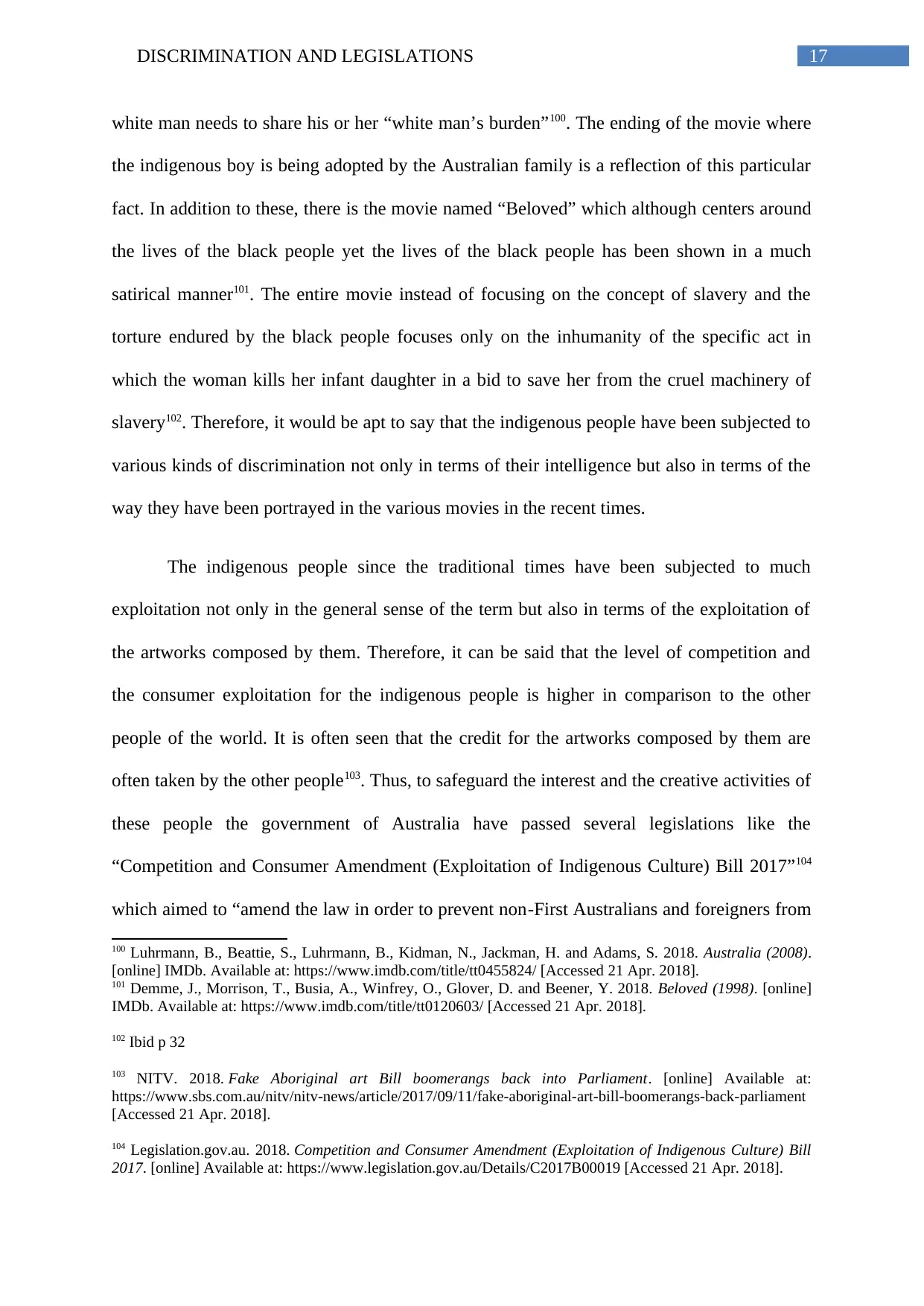
17DISCRIMINATION AND LEGISLATIONS
white man needs to share his or her “white man’s burden”100. The ending of the movie where
the indigenous boy is being adopted by the Australian family is a reflection of this particular
fact. In addition to these, there is the movie named “Beloved” which although centers around
the lives of the black people yet the lives of the black people has been shown in a much
satirical manner101. The entire movie instead of focusing on the concept of slavery and the
torture endured by the black people focuses only on the inhumanity of the specific act in
which the woman kills her infant daughter in a bid to save her from the cruel machinery of
slavery102. Therefore, it would be apt to say that the indigenous people have been subjected to
various kinds of discrimination not only in terms of their intelligence but also in terms of the
way they have been portrayed in the various movies in the recent times.
The indigenous people since the traditional times have been subjected to much
exploitation not only in the general sense of the term but also in terms of the exploitation of
the artworks composed by them. Therefore, it can be said that the level of competition and
the consumer exploitation for the indigenous people is higher in comparison to the other
people of the world. It is often seen that the credit for the artworks composed by them are
often taken by the other people103. Thus, to safeguard the interest and the creative activities of
these people the government of Australia have passed several legislations like the
“Competition and Consumer Amendment (Exploitation of Indigenous Culture) Bill 2017”104
which aimed to “amend the law in order to prevent non-First Australians and foreigners from
100 Luhrmann, B., Beattie, S., Luhrmann, B., Kidman, N., Jackman, H. and Adams, S. 2018. Australia (2008).
[online] IMDb. Available at: https://www.imdb.com/title/tt0455824/ [Accessed 21 Apr. 2018].
101 Demme, J., Morrison, T., Busia, A., Winfrey, O., Glover, D. and Beener, Y. 2018. Beloved (1998). [online]
IMDb. Available at: https://www.imdb.com/title/tt0120603/ [Accessed 21 Apr. 2018].
102 Ibid p 32
103 NITV. 2018. Fake Aboriginal art Bill boomerangs back into Parliament. [online] Available at:
https://www.sbs.com.au/nitv/nitv-news/article/2017/09/11/fake-aboriginal-art-bill-boomerangs-back-parliament
[Accessed 21 Apr. 2018].
104 Legislation.gov.au. 2018. Competition and Consumer Amendment (Exploitation of Indigenous Culture) Bill
2017. [online] Available at: https://www.legislation.gov.au/Details/C2017B00019 [Accessed 21 Apr. 2018].
white man needs to share his or her “white man’s burden”100. The ending of the movie where
the indigenous boy is being adopted by the Australian family is a reflection of this particular
fact. In addition to these, there is the movie named “Beloved” which although centers around
the lives of the black people yet the lives of the black people has been shown in a much
satirical manner101. The entire movie instead of focusing on the concept of slavery and the
torture endured by the black people focuses only on the inhumanity of the specific act in
which the woman kills her infant daughter in a bid to save her from the cruel machinery of
slavery102. Therefore, it would be apt to say that the indigenous people have been subjected to
various kinds of discrimination not only in terms of their intelligence but also in terms of the
way they have been portrayed in the various movies in the recent times.
The indigenous people since the traditional times have been subjected to much
exploitation not only in the general sense of the term but also in terms of the exploitation of
the artworks composed by them. Therefore, it can be said that the level of competition and
the consumer exploitation for the indigenous people is higher in comparison to the other
people of the world. It is often seen that the credit for the artworks composed by them are
often taken by the other people103. Thus, to safeguard the interest and the creative activities of
these people the government of Australia have passed several legislations like the
“Competition and Consumer Amendment (Exploitation of Indigenous Culture) Bill 2017”104
which aimed to “amend the law in order to prevent non-First Australians and foreigners from
100 Luhrmann, B., Beattie, S., Luhrmann, B., Kidman, N., Jackman, H. and Adams, S. 2018. Australia (2008).
[online] IMDb. Available at: https://www.imdb.com/title/tt0455824/ [Accessed 21 Apr. 2018].
101 Demme, J., Morrison, T., Busia, A., Winfrey, O., Glover, D. and Beener, Y. 2018. Beloved (1998). [online]
IMDb. Available at: https://www.imdb.com/title/tt0120603/ [Accessed 21 Apr. 2018].
102 Ibid p 32
103 NITV. 2018. Fake Aboriginal art Bill boomerangs back into Parliament. [online] Available at:
https://www.sbs.com.au/nitv/nitv-news/article/2017/09/11/fake-aboriginal-art-bill-boomerangs-back-parliament
[Accessed 21 Apr. 2018].
104 Legislation.gov.au. 2018. Competition and Consumer Amendment (Exploitation of Indigenous Culture) Bill
2017. [online] Available at: https://www.legislation.gov.au/Details/C2017B00019 [Accessed 21 Apr. 2018].
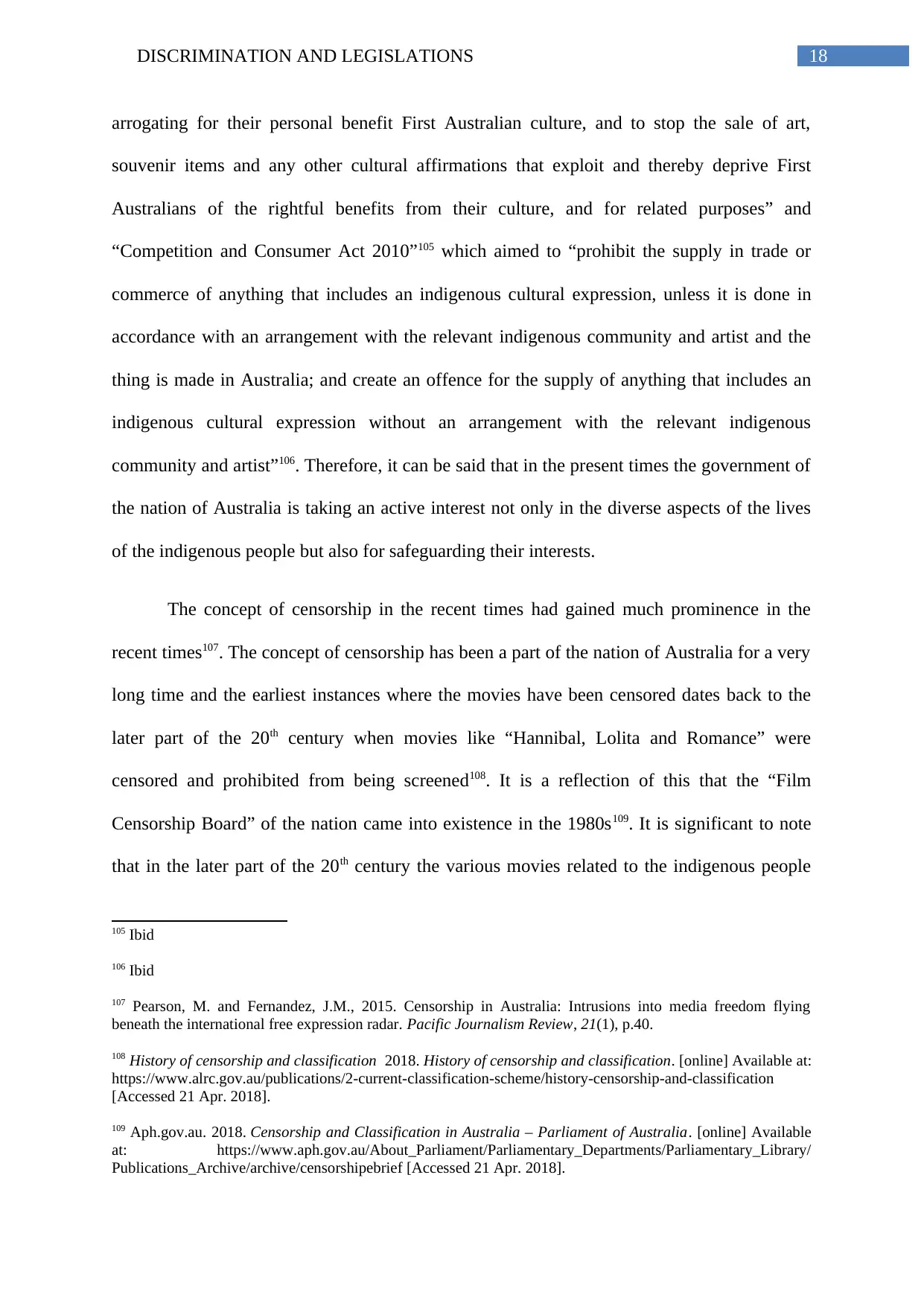
18DISCRIMINATION AND LEGISLATIONS
arrogating for their personal benefit First Australian culture, and to stop the sale of art,
souvenir items and any other cultural affirmations that exploit and thereby deprive First
Australians of the rightful benefits from their culture, and for related purposes” and
“Competition and Consumer Act 2010”105 which aimed to “prohibit the supply in trade or
commerce of anything that includes an indigenous cultural expression, unless it is done in
accordance with an arrangement with the relevant indigenous community and artist and the
thing is made in Australia; and create an offence for the supply of anything that includes an
indigenous cultural expression without an arrangement with the relevant indigenous
community and artist”106. Therefore, it can be said that in the present times the government of
the nation of Australia is taking an active interest not only in the diverse aspects of the lives
of the indigenous people but also for safeguarding their interests.
The concept of censorship in the recent times had gained much prominence in the
recent times107. The concept of censorship has been a part of the nation of Australia for a very
long time and the earliest instances where the movies have been censored dates back to the
later part of the 20th century when movies like “Hannibal, Lolita and Romance” were
censored and prohibited from being screened108. It is a reflection of this that the “Film
Censorship Board” of the nation came into existence in the 1980s109. It is significant to note
that in the later part of the 20th century the various movies related to the indigenous people
105 Ibid
106 Ibid
107 Pearson, M. and Fernandez, J.M., 2015. Censorship in Australia: Intrusions into media freedom flying
beneath the international free expression radar. Pacific Journalism Review, 21(1), p.40.
108 History of censorship and classification 2018. History of censorship and classification. [online] Available at:
https://www.alrc.gov.au/publications/2-current-classification-scheme/history-censorship-and-classification
[Accessed 21 Apr. 2018].
109 Aph.gov.au. 2018. Censorship and Classification in Australia – Parliament of Australia. [online] Available
at: https://www.aph.gov.au/About_Parliament/Parliamentary_Departments/Parliamentary_Library/
Publications_Archive/archive/censorshipebrief [Accessed 21 Apr. 2018].
arrogating for their personal benefit First Australian culture, and to stop the sale of art,
souvenir items and any other cultural affirmations that exploit and thereby deprive First
Australians of the rightful benefits from their culture, and for related purposes” and
“Competition and Consumer Act 2010”105 which aimed to “prohibit the supply in trade or
commerce of anything that includes an indigenous cultural expression, unless it is done in
accordance with an arrangement with the relevant indigenous community and artist and the
thing is made in Australia; and create an offence for the supply of anything that includes an
indigenous cultural expression without an arrangement with the relevant indigenous
community and artist”106. Therefore, it can be said that in the present times the government of
the nation of Australia is taking an active interest not only in the diverse aspects of the lives
of the indigenous people but also for safeguarding their interests.
The concept of censorship in the recent times had gained much prominence in the
recent times107. The concept of censorship has been a part of the nation of Australia for a very
long time and the earliest instances where the movies have been censored dates back to the
later part of the 20th century when movies like “Hannibal, Lolita and Romance” were
censored and prohibited from being screened108. It is a reflection of this that the “Film
Censorship Board” of the nation came into existence in the 1980s109. It is significant to note
that in the later part of the 20th century the various movies related to the indigenous people
105 Ibid
106 Ibid
107 Pearson, M. and Fernandez, J.M., 2015. Censorship in Australia: Intrusions into media freedom flying
beneath the international free expression radar. Pacific Journalism Review, 21(1), p.40.
108 History of censorship and classification 2018. History of censorship and classification. [online] Available at:
https://www.alrc.gov.au/publications/2-current-classification-scheme/history-censorship-and-classification
[Accessed 21 Apr. 2018].
109 Aph.gov.au. 2018. Censorship and Classification in Australia – Parliament of Australia. [online] Available
at: https://www.aph.gov.au/About_Parliament/Parliamentary_Departments/Parliamentary_Library/
Publications_Archive/archive/censorshipebrief [Accessed 21 Apr. 2018].
Paraphrase This Document
Need a fresh take? Get an instant paraphrase of this document with our AI Paraphraser
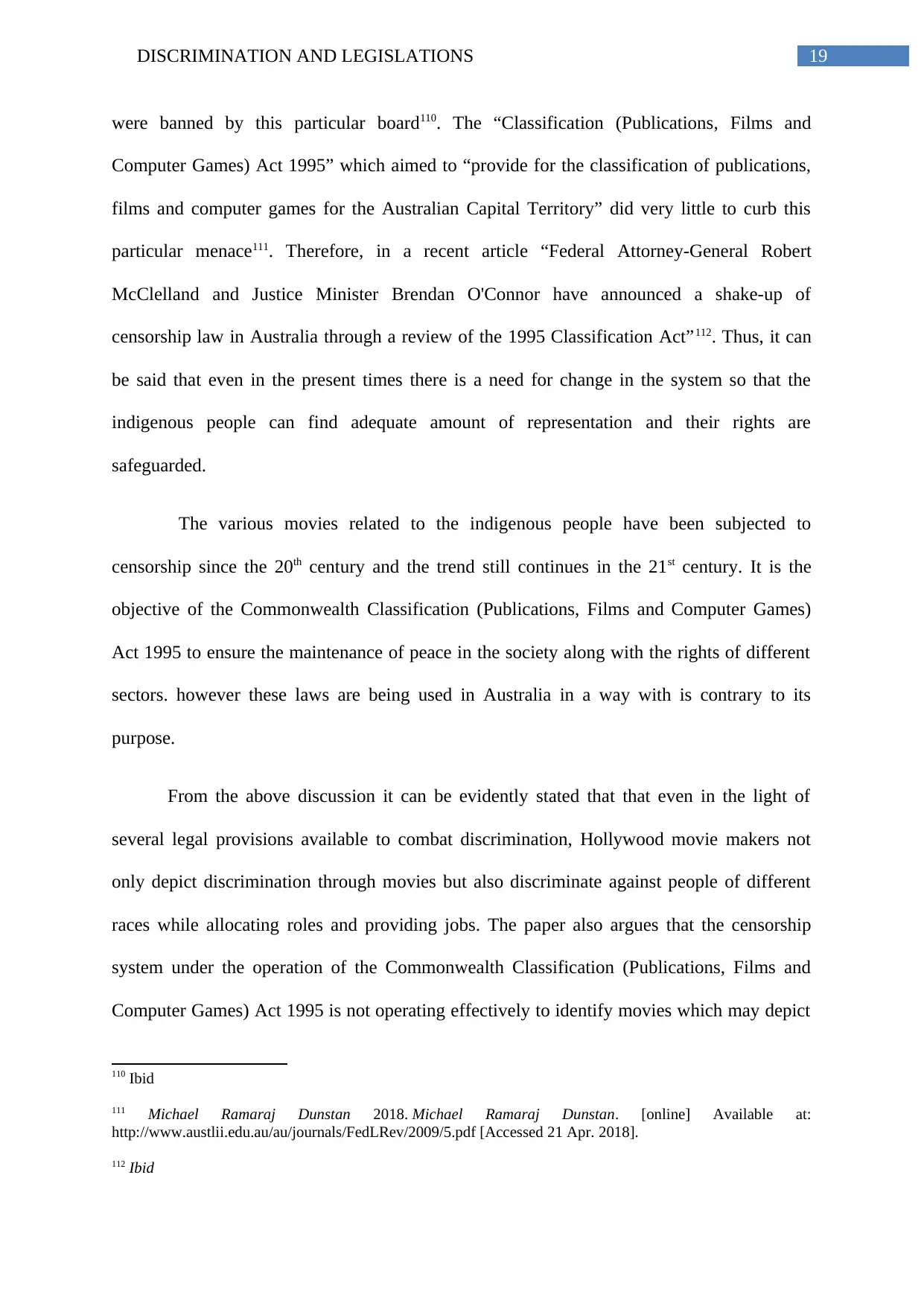
19DISCRIMINATION AND LEGISLATIONS
were banned by this particular board110. The “Classification (Publications, Films and
Computer Games) Act 1995” which aimed to “provide for the classification of publications,
films and computer games for the Australian Capital Territory” did very little to curb this
particular menace111. Therefore, in a recent article “Federal Attorney-General Robert
McClelland and Justice Minister Brendan O'Connor have announced a shake-up of
censorship law in Australia through a review of the 1995 Classification Act”112. Thus, it can
be said that even in the present times there is a need for change in the system so that the
indigenous people can find adequate amount of representation and their rights are
safeguarded.
The various movies related to the indigenous people have been subjected to
censorship since the 20th century and the trend still continues in the 21st century. It is the
objective of the Commonwealth Classification (Publications, Films and Computer Games)
Act 1995 to ensure the maintenance of peace in the society along with the rights of different
sectors. however these laws are being used in Australia in a way with is contrary to its
purpose.
From the above discussion it can be evidently stated that that even in the light of
several legal provisions available to combat discrimination, Hollywood movie makers not
only depict discrimination through movies but also discriminate against people of different
races while allocating roles and providing jobs. The paper also argues that the censorship
system under the operation of the Commonwealth Classification (Publications, Films and
Computer Games) Act 1995 is not operating effectively to identify movies which may depict
110 Ibid
111 Michael Ramaraj Dunstan 2018. Michael Ramaraj Dunstan. [online] Available at:
http://www.austlii.edu.au/au/journals/FedLRev/2009/5.pdf [Accessed 21 Apr. 2018].
112 Ibid
were banned by this particular board110. The “Classification (Publications, Films and
Computer Games) Act 1995” which aimed to “provide for the classification of publications,
films and computer games for the Australian Capital Territory” did very little to curb this
particular menace111. Therefore, in a recent article “Federal Attorney-General Robert
McClelland and Justice Minister Brendan O'Connor have announced a shake-up of
censorship law in Australia through a review of the 1995 Classification Act”112. Thus, it can
be said that even in the present times there is a need for change in the system so that the
indigenous people can find adequate amount of representation and their rights are
safeguarded.
The various movies related to the indigenous people have been subjected to
censorship since the 20th century and the trend still continues in the 21st century. It is the
objective of the Commonwealth Classification (Publications, Films and Computer Games)
Act 1995 to ensure the maintenance of peace in the society along with the rights of different
sectors. however these laws are being used in Australia in a way with is contrary to its
purpose.
From the above discussion it can be evidently stated that that even in the light of
several legal provisions available to combat discrimination, Hollywood movie makers not
only depict discrimination through movies but also discriminate against people of different
races while allocating roles and providing jobs. The paper also argues that the censorship
system under the operation of the Commonwealth Classification (Publications, Films and
Computer Games) Act 1995 is not operating effectively to identify movies which may depict
110 Ibid
111 Michael Ramaraj Dunstan 2018. Michael Ramaraj Dunstan. [online] Available at:
http://www.austlii.edu.au/au/journals/FedLRev/2009/5.pdf [Accessed 21 Apr. 2018].
112 Ibid
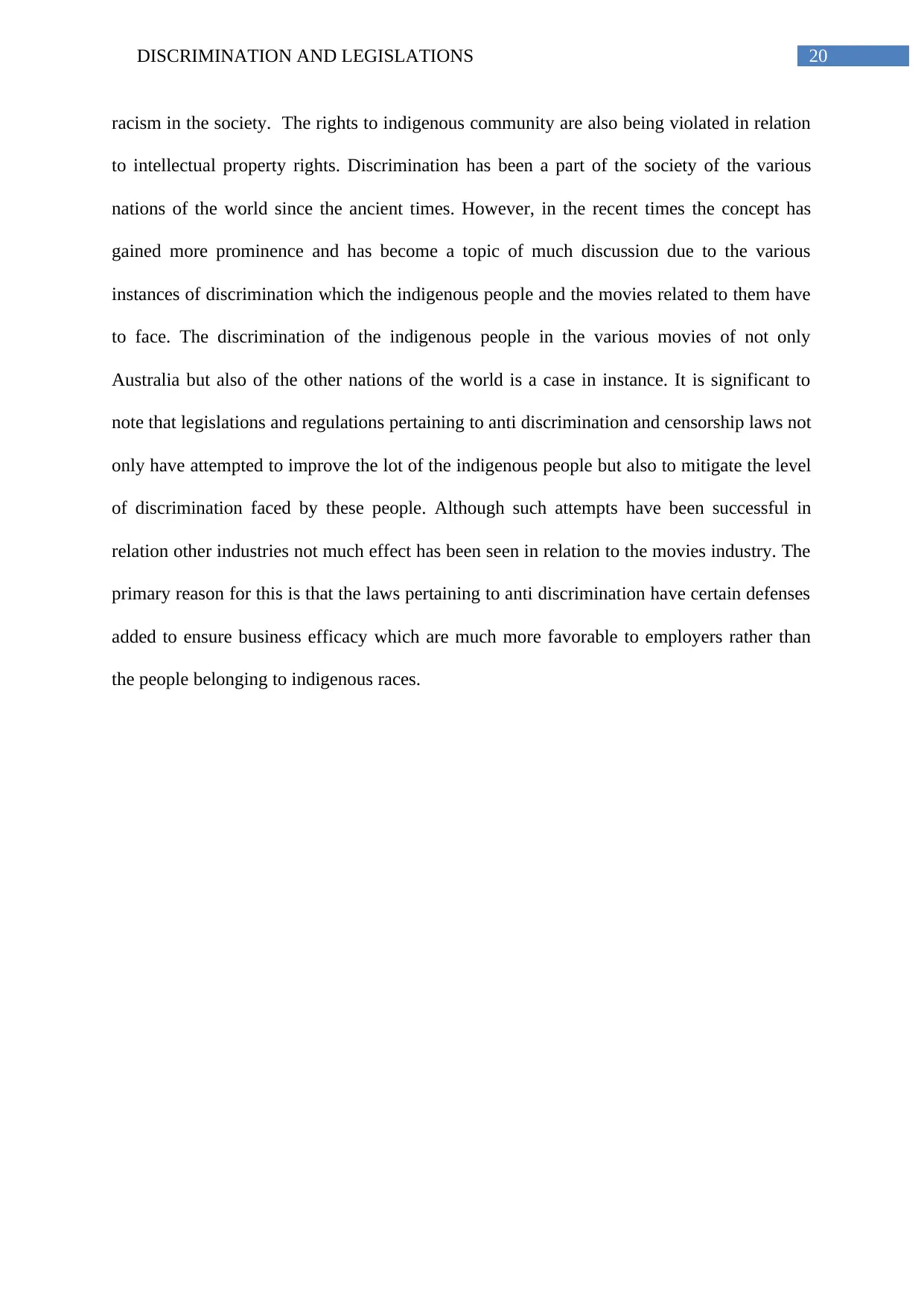
20DISCRIMINATION AND LEGISLATIONS
racism in the society. The rights to indigenous community are also being violated in relation
to intellectual property rights. Discrimination has been a part of the society of the various
nations of the world since the ancient times. However, in the recent times the concept has
gained more prominence and has become a topic of much discussion due to the various
instances of discrimination which the indigenous people and the movies related to them have
to face. The discrimination of the indigenous people in the various movies of not only
Australia but also of the other nations of the world is a case in instance. It is significant to
note that legislations and regulations pertaining to anti discrimination and censorship laws not
only have attempted to improve the lot of the indigenous people but also to mitigate the level
of discrimination faced by these people. Although such attempts have been successful in
relation other industries not much effect has been seen in relation to the movies industry. The
primary reason for this is that the laws pertaining to anti discrimination have certain defenses
added to ensure business efficacy which are much more favorable to employers rather than
the people belonging to indigenous races.
racism in the society. The rights to indigenous community are also being violated in relation
to intellectual property rights. Discrimination has been a part of the society of the various
nations of the world since the ancient times. However, in the recent times the concept has
gained more prominence and has become a topic of much discussion due to the various
instances of discrimination which the indigenous people and the movies related to them have
to face. The discrimination of the indigenous people in the various movies of not only
Australia but also of the other nations of the world is a case in instance. It is significant to
note that legislations and regulations pertaining to anti discrimination and censorship laws not
only have attempted to improve the lot of the indigenous people but also to mitigate the level
of discrimination faced by these people. Although such attempts have been successful in
relation other industries not much effect has been seen in relation to the movies industry. The
primary reason for this is that the laws pertaining to anti discrimination have certain defenses
added to ensure business efficacy which are much more favorable to employers rather than
the people belonging to indigenous races.
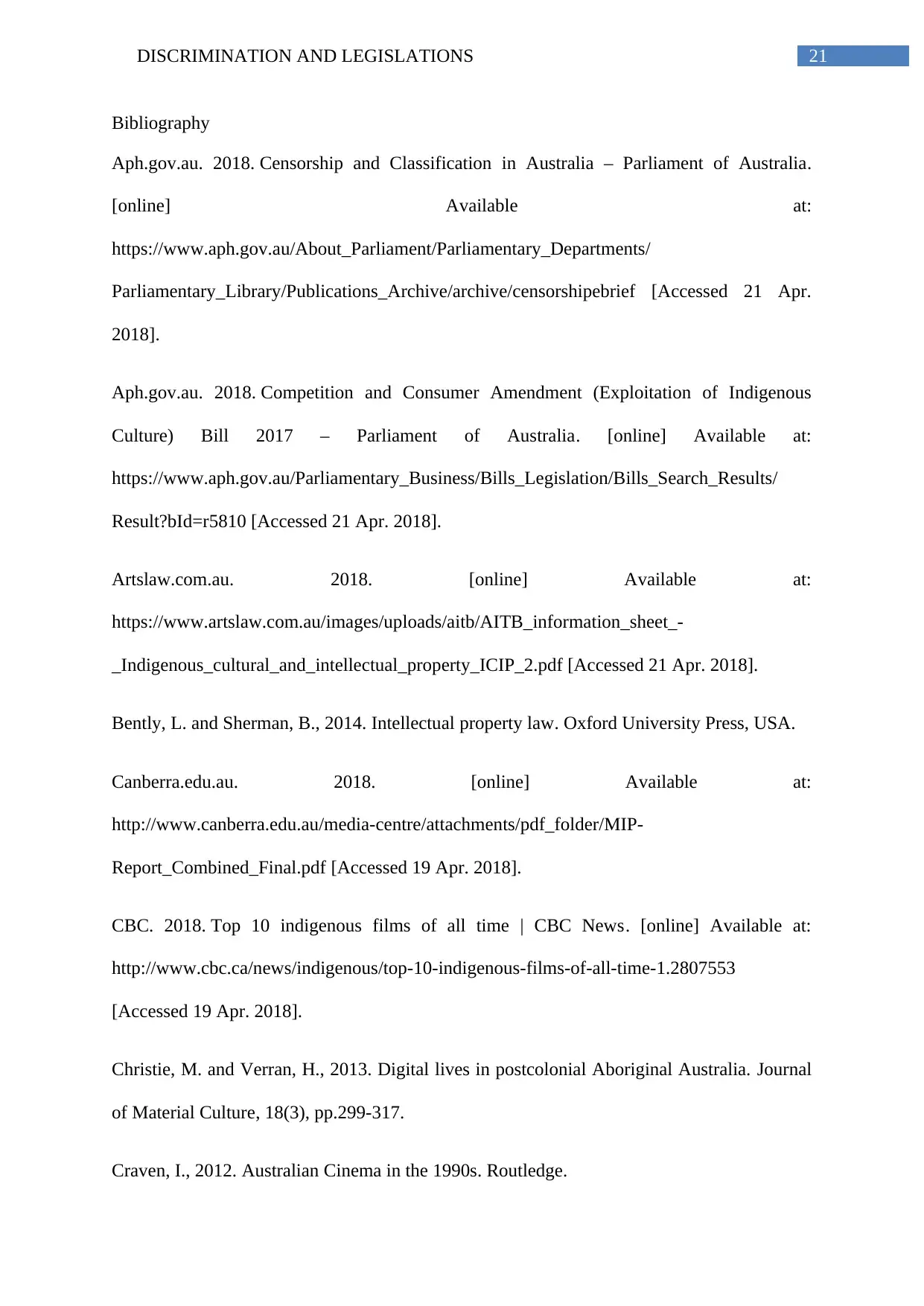
21DISCRIMINATION AND LEGISLATIONS
Bibliography
Aph.gov.au. 2018. Censorship and Classification in Australia – Parliament of Australia.
[online] Available at:
https://www.aph.gov.au/About_Parliament/Parliamentary_Departments/
Parliamentary_Library/Publications_Archive/archive/censorshipebrief [Accessed 21 Apr.
2018].
Aph.gov.au. 2018. Competition and Consumer Amendment (Exploitation of Indigenous
Culture) Bill 2017 – Parliament of Australia. [online] Available at:
https://www.aph.gov.au/Parliamentary_Business/Bills_Legislation/Bills_Search_Results/
Result?bId=r5810 [Accessed 21 Apr. 2018].
Artslaw.com.au. 2018. [online] Available at:
https://www.artslaw.com.au/images/uploads/aitb/AITB_information_sheet_-
_Indigenous_cultural_and_intellectual_property_ICIP_2.pdf [Accessed 21 Apr. 2018].
Bently, L. and Sherman, B., 2014. Intellectual property law. Oxford University Press, USA.
Canberra.edu.au. 2018. [online] Available at:
http://www.canberra.edu.au/media-centre/attachments/pdf_folder/MIP-
Report_Combined_Final.pdf [Accessed 19 Apr. 2018].
CBC. 2018. Top 10 indigenous films of all time | CBC News. [online] Available at:
http://www.cbc.ca/news/indigenous/top-10-indigenous-films-of-all-time-1.2807553
[Accessed 19 Apr. 2018].
Christie, M. and Verran, H., 2013. Digital lives in postcolonial Aboriginal Australia. Journal
of Material Culture, 18(3), pp.299-317.
Craven, I., 2012. Australian Cinema in the 1990s. Routledge.
Bibliography
Aph.gov.au. 2018. Censorship and Classification in Australia – Parliament of Australia.
[online] Available at:
https://www.aph.gov.au/About_Parliament/Parliamentary_Departments/
Parliamentary_Library/Publications_Archive/archive/censorshipebrief [Accessed 21 Apr.
2018].
Aph.gov.au. 2018. Competition and Consumer Amendment (Exploitation of Indigenous
Culture) Bill 2017 – Parliament of Australia. [online] Available at:
https://www.aph.gov.au/Parliamentary_Business/Bills_Legislation/Bills_Search_Results/
Result?bId=r5810 [Accessed 21 Apr. 2018].
Artslaw.com.au. 2018. [online] Available at:
https://www.artslaw.com.au/images/uploads/aitb/AITB_information_sheet_-
_Indigenous_cultural_and_intellectual_property_ICIP_2.pdf [Accessed 21 Apr. 2018].
Bently, L. and Sherman, B., 2014. Intellectual property law. Oxford University Press, USA.
Canberra.edu.au. 2018. [online] Available at:
http://www.canberra.edu.au/media-centre/attachments/pdf_folder/MIP-
Report_Combined_Final.pdf [Accessed 19 Apr. 2018].
CBC. 2018. Top 10 indigenous films of all time | CBC News. [online] Available at:
http://www.cbc.ca/news/indigenous/top-10-indigenous-films-of-all-time-1.2807553
[Accessed 19 Apr. 2018].
Christie, M. and Verran, H., 2013. Digital lives in postcolonial Aboriginal Australia. Journal
of Material Culture, 18(3), pp.299-317.
Craven, I., 2012. Australian Cinema in the 1990s. Routledge.
Secure Best Marks with AI Grader
Need help grading? Try our AI Grader for instant feedback on your assignments.
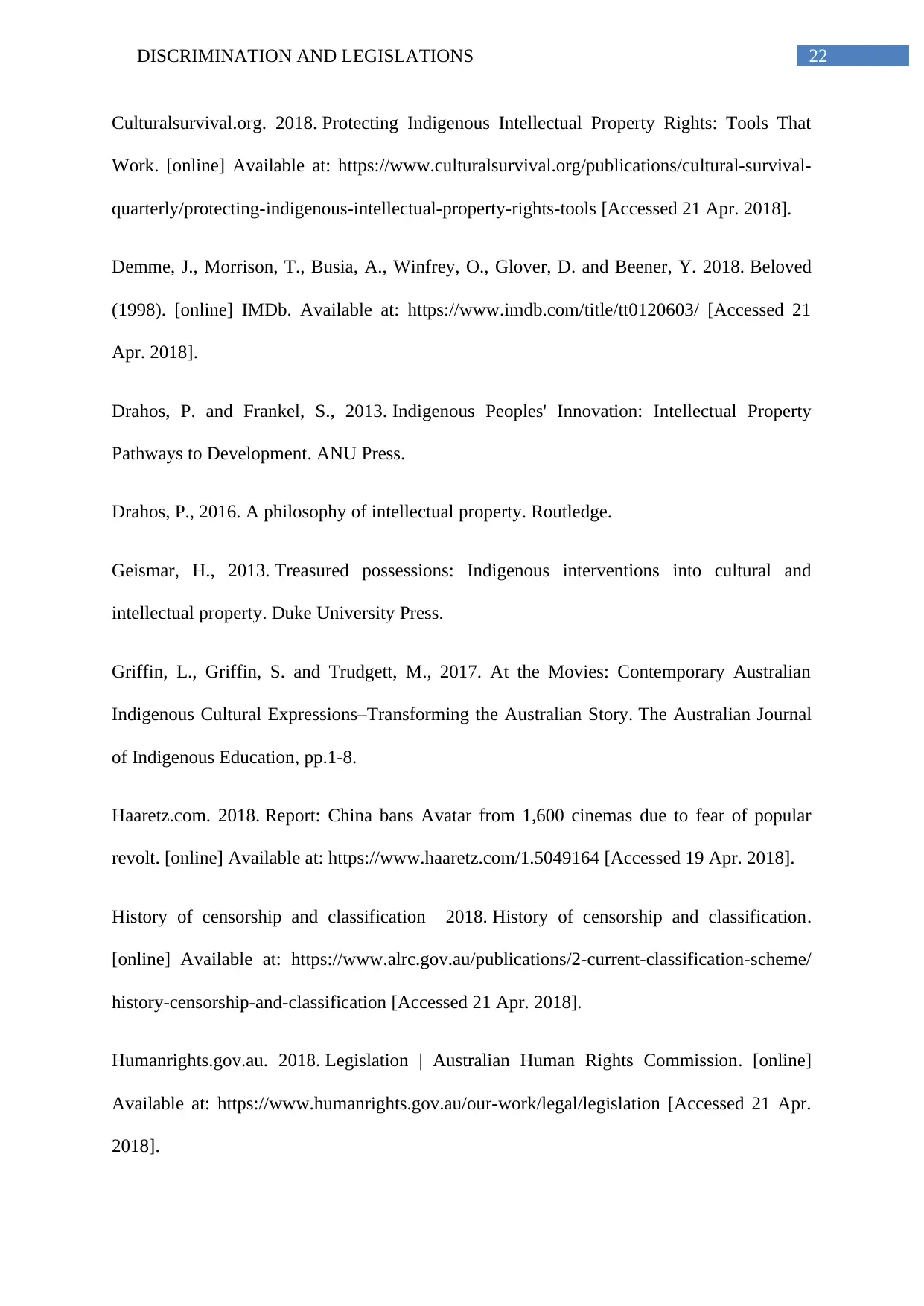
22DISCRIMINATION AND LEGISLATIONS
Culturalsurvival.org. 2018. Protecting Indigenous Intellectual Property Rights: Tools That
Work. [online] Available at: https://www.culturalsurvival.org/publications/cultural-survival-
quarterly/protecting-indigenous-intellectual-property-rights-tools [Accessed 21 Apr. 2018].
Demme, J., Morrison, T., Busia, A., Winfrey, O., Glover, D. and Beener, Y. 2018. Beloved
(1998). [online] IMDb. Available at: https://www.imdb.com/title/tt0120603/ [Accessed 21
Apr. 2018].
Drahos, P. and Frankel, S., 2013. Indigenous Peoples' Innovation: Intellectual Property
Pathways to Development. ANU Press.
Drahos, P., 2016. A philosophy of intellectual property. Routledge.
Geismar, H., 2013. Treasured possessions: Indigenous interventions into cultural and
intellectual property. Duke University Press.
Griffin, L., Griffin, S. and Trudgett, M., 2017. At the Movies: Contemporary Australian
Indigenous Cultural Expressions–Transforming the Australian Story. The Australian Journal
of Indigenous Education, pp.1-8.
Haaretz.com. 2018. Report: China bans Avatar from 1,600 cinemas due to fear of popular
revolt. [online] Available at: https://www.haaretz.com/1.5049164 [Accessed 19 Apr. 2018].
History of censorship and classification 2018. History of censorship and classification.
[online] Available at: https://www.alrc.gov.au/publications/2-current-classification-scheme/
history-censorship-and-classification [Accessed 21 Apr. 2018].
Humanrights.gov.au. 2018. Legislation | Australian Human Rights Commission. [online]
Available at: https://www.humanrights.gov.au/our-work/legal/legislation [Accessed 21 Apr.
2018].
Culturalsurvival.org. 2018. Protecting Indigenous Intellectual Property Rights: Tools That
Work. [online] Available at: https://www.culturalsurvival.org/publications/cultural-survival-
quarterly/protecting-indigenous-intellectual-property-rights-tools [Accessed 21 Apr. 2018].
Demme, J., Morrison, T., Busia, A., Winfrey, O., Glover, D. and Beener, Y. 2018. Beloved
(1998). [online] IMDb. Available at: https://www.imdb.com/title/tt0120603/ [Accessed 21
Apr. 2018].
Drahos, P. and Frankel, S., 2013. Indigenous Peoples' Innovation: Intellectual Property
Pathways to Development. ANU Press.
Drahos, P., 2016. A philosophy of intellectual property. Routledge.
Geismar, H., 2013. Treasured possessions: Indigenous interventions into cultural and
intellectual property. Duke University Press.
Griffin, L., Griffin, S. and Trudgett, M., 2017. At the Movies: Contemporary Australian
Indigenous Cultural Expressions–Transforming the Australian Story. The Australian Journal
of Indigenous Education, pp.1-8.
Haaretz.com. 2018. Report: China bans Avatar from 1,600 cinemas due to fear of popular
revolt. [online] Available at: https://www.haaretz.com/1.5049164 [Accessed 19 Apr. 2018].
History of censorship and classification 2018. History of censorship and classification.
[online] Available at: https://www.alrc.gov.au/publications/2-current-classification-scheme/
history-censorship-and-classification [Accessed 21 Apr. 2018].
Humanrights.gov.au. 2018. Legislation | Australian Human Rights Commission. [online]
Available at: https://www.humanrights.gov.au/our-work/legal/legislation [Accessed 21 Apr.
2018].
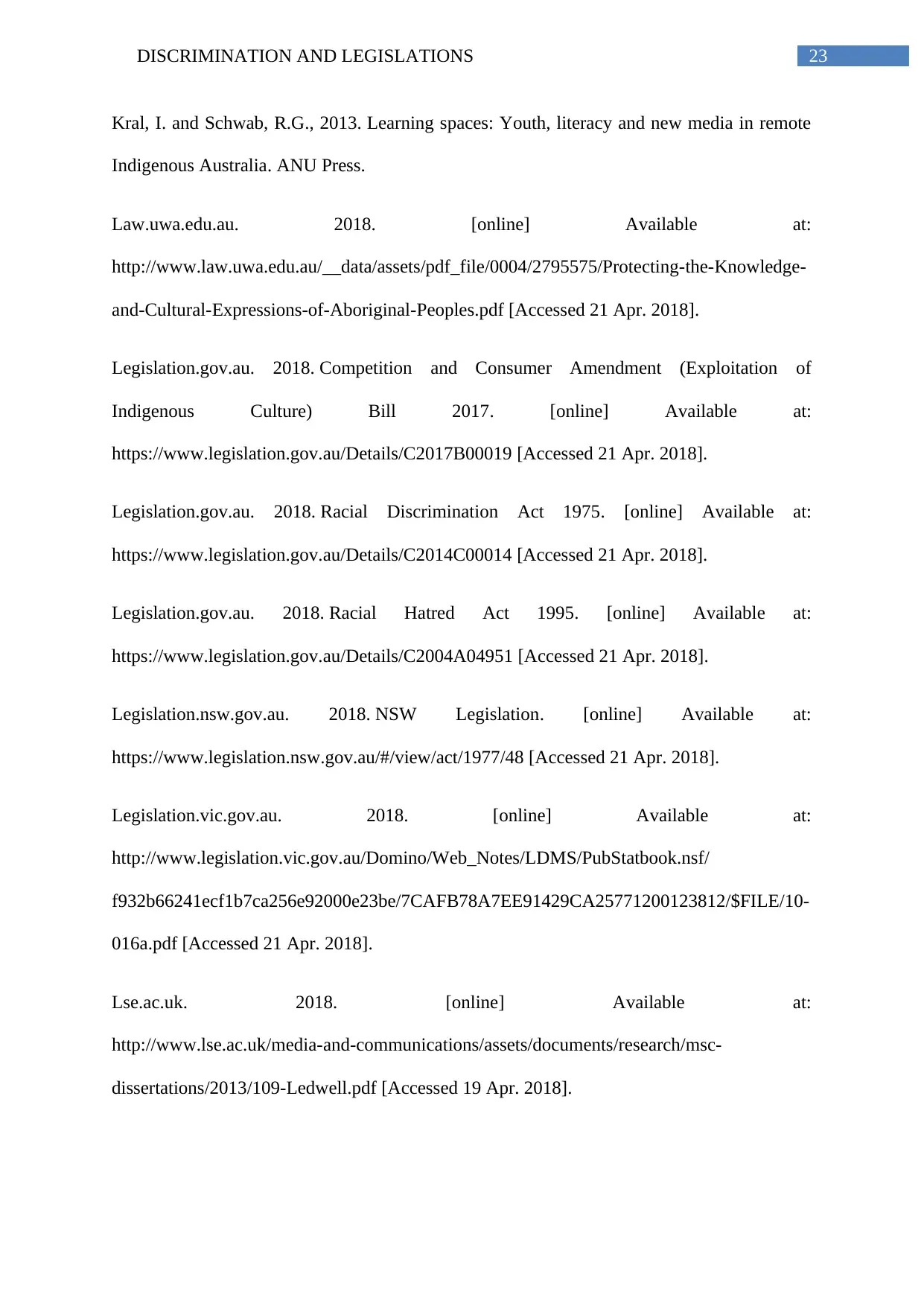
23DISCRIMINATION AND LEGISLATIONS
Kral, I. and Schwab, R.G., 2013. Learning spaces: Youth, literacy and new media in remote
Indigenous Australia. ANU Press.
Law.uwa.edu.au. 2018. [online] Available at:
http://www.law.uwa.edu.au/__data/assets/pdf_file/0004/2795575/Protecting-the-Knowledge-
and-Cultural-Expressions-of-Aboriginal-Peoples.pdf [Accessed 21 Apr. 2018].
Legislation.gov.au. 2018. Competition and Consumer Amendment (Exploitation of
Indigenous Culture) Bill 2017. [online] Available at:
https://www.legislation.gov.au/Details/C2017B00019 [Accessed 21 Apr. 2018].
Legislation.gov.au. 2018. Racial Discrimination Act 1975. [online] Available at:
https://www.legislation.gov.au/Details/C2014C00014 [Accessed 21 Apr. 2018].
Legislation.gov.au. 2018. Racial Hatred Act 1995. [online] Available at:
https://www.legislation.gov.au/Details/C2004A04951 [Accessed 21 Apr. 2018].
Legislation.nsw.gov.au. 2018. NSW Legislation. [online] Available at:
https://www.legislation.nsw.gov.au/#/view/act/1977/48 [Accessed 21 Apr. 2018].
Legislation.vic.gov.au. 2018. [online] Available at:
http://www.legislation.vic.gov.au/Domino/Web_Notes/LDMS/PubStatbook.nsf/
f932b66241ecf1b7ca256e92000e23be/7CAFB78A7EE91429CA25771200123812/$FILE/10-
016a.pdf [Accessed 21 Apr. 2018].
Lse.ac.uk. 2018. [online] Available at:
http://www.lse.ac.uk/media-and-communications/assets/documents/research/msc-
dissertations/2013/109-Ledwell.pdf [Accessed 19 Apr. 2018].
Kral, I. and Schwab, R.G., 2013. Learning spaces: Youth, literacy and new media in remote
Indigenous Australia. ANU Press.
Law.uwa.edu.au. 2018. [online] Available at:
http://www.law.uwa.edu.au/__data/assets/pdf_file/0004/2795575/Protecting-the-Knowledge-
and-Cultural-Expressions-of-Aboriginal-Peoples.pdf [Accessed 21 Apr. 2018].
Legislation.gov.au. 2018. Competition and Consumer Amendment (Exploitation of
Indigenous Culture) Bill 2017. [online] Available at:
https://www.legislation.gov.au/Details/C2017B00019 [Accessed 21 Apr. 2018].
Legislation.gov.au. 2018. Racial Discrimination Act 1975. [online] Available at:
https://www.legislation.gov.au/Details/C2014C00014 [Accessed 21 Apr. 2018].
Legislation.gov.au. 2018. Racial Hatred Act 1995. [online] Available at:
https://www.legislation.gov.au/Details/C2004A04951 [Accessed 21 Apr. 2018].
Legislation.nsw.gov.au. 2018. NSW Legislation. [online] Available at:
https://www.legislation.nsw.gov.au/#/view/act/1977/48 [Accessed 21 Apr. 2018].
Legislation.vic.gov.au. 2018. [online] Available at:
http://www.legislation.vic.gov.au/Domino/Web_Notes/LDMS/PubStatbook.nsf/
f932b66241ecf1b7ca256e92000e23be/7CAFB78A7EE91429CA25771200123812/$FILE/10-
016a.pdf [Accessed 21 Apr. 2018].
Lse.ac.uk. 2018. [online] Available at:
http://www.lse.ac.uk/media-and-communications/assets/documents/research/msc-
dissertations/2013/109-Ledwell.pdf [Accessed 19 Apr. 2018].

24DISCRIMINATION AND LEGISLATIONS
Luhrmann, B., Beattie, S., Luhrmann, B., Kidman, N., Jackman, H. and Adams, S.
2018. Australia (2008). [online] IMDb. Available at: https://www.imdb.com/title/tt0455824/
[Accessed 21 Apr. 2018].
Manderson, D., 2012. The Law of the Image and the Image of the Law: Colonial
Representations of the Rule of Law. NYL Sch. L. Rev., 57, p.153.
May, C., 2015. The global political economy of intellectual property rights: The new
enclosures. Routledge.
Michael Ramaraj Dunstan 2018. Michael Ramaraj Dunstan. [online] Available at:
http://www.austlii.edu.au/au/journals/FedLRev/2009/5.pdf [Accessed 21 Apr. 2018].
Neville, H.A., Oyama, K.E., Odunewu, L.O. and Huggins, J.G., 2014. Dimensions of
belonging as an aspect of racial-ethnic-cultural identity: An exploration of indigenous
Australians. Journal of counseling psychology, 61(3), p.414.
NITV. 2018. 5 Indigenous films that changed the national conversation. [online] Available at:
https://www.sbs.com.au/nitv/article/2017/07/18/5-indigenous-films-changed-national-
conversation [Accessed 21 Apr. 2018].
NITV. 2018. Fake Aboriginal art Bill boomerangs back into Parliament. [online] Available
at: https://www.sbs.com.au/nitv/nitv-news/article/2017/09/11/fake-aboriginal-art-bill-
boomerangs-back-parliament [Accessed 21 Apr. 2018].
Ottosson, Å., 2012. The intercultural crafting of real Aboriginal country and manhood in
Central Australia. The Australian Journal of Anthropology, 23(2), pp.179-196.
Paradies, Y., 2016. Beyond black and white: Essentialism, hybridity and indigeneity.
In Handbook of Indigenous Peoples' Rights (pp. 44-54). Routledge.
Luhrmann, B., Beattie, S., Luhrmann, B., Kidman, N., Jackman, H. and Adams, S.
2018. Australia (2008). [online] IMDb. Available at: https://www.imdb.com/title/tt0455824/
[Accessed 21 Apr. 2018].
Manderson, D., 2012. The Law of the Image and the Image of the Law: Colonial
Representations of the Rule of Law. NYL Sch. L. Rev., 57, p.153.
May, C., 2015. The global political economy of intellectual property rights: The new
enclosures. Routledge.
Michael Ramaraj Dunstan 2018. Michael Ramaraj Dunstan. [online] Available at:
http://www.austlii.edu.au/au/journals/FedLRev/2009/5.pdf [Accessed 21 Apr. 2018].
Neville, H.A., Oyama, K.E., Odunewu, L.O. and Huggins, J.G., 2014. Dimensions of
belonging as an aspect of racial-ethnic-cultural identity: An exploration of indigenous
Australians. Journal of counseling psychology, 61(3), p.414.
NITV. 2018. 5 Indigenous films that changed the national conversation. [online] Available at:
https://www.sbs.com.au/nitv/article/2017/07/18/5-indigenous-films-changed-national-
conversation [Accessed 21 Apr. 2018].
NITV. 2018. Fake Aboriginal art Bill boomerangs back into Parliament. [online] Available
at: https://www.sbs.com.au/nitv/nitv-news/article/2017/09/11/fake-aboriginal-art-bill-
boomerangs-back-parliament [Accessed 21 Apr. 2018].
Ottosson, Å., 2012. The intercultural crafting of real Aboriginal country and manhood in
Central Australia. The Australian Journal of Anthropology, 23(2), pp.179-196.
Paradies, Y., 2016. Beyond black and white: Essentialism, hybridity and indigeneity.
In Handbook of Indigenous Peoples' Rights (pp. 44-54). Routledge.
Paraphrase This Document
Need a fresh take? Get an instant paraphrase of this document with our AI Paraphraser
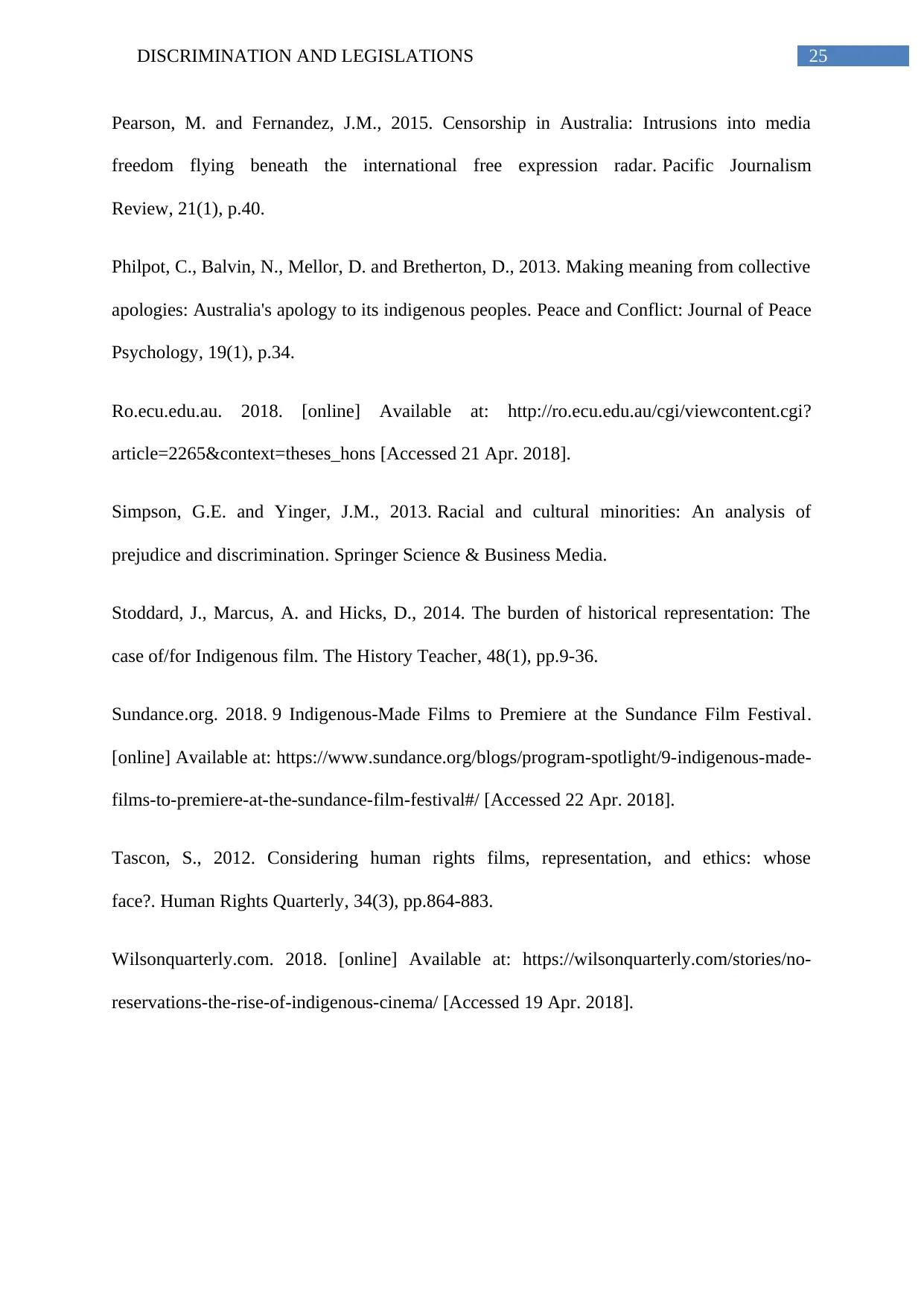
25DISCRIMINATION AND LEGISLATIONS
Pearson, M. and Fernandez, J.M., 2015. Censorship in Australia: Intrusions into media
freedom flying beneath the international free expression radar. Pacific Journalism
Review, 21(1), p.40.
Philpot, C., Balvin, N., Mellor, D. and Bretherton, D., 2013. Making meaning from collective
apologies: Australia's apology to its indigenous peoples. Peace and Conflict: Journal of Peace
Psychology, 19(1), p.34.
Ro.ecu.edu.au. 2018. [online] Available at: http://ro.ecu.edu.au/cgi/viewcontent.cgi?
article=2265&context=theses_hons [Accessed 21 Apr. 2018].
Simpson, G.E. and Yinger, J.M., 2013. Racial and cultural minorities: An analysis of
prejudice and discrimination. Springer Science & Business Media.
Stoddard, J., Marcus, A. and Hicks, D., 2014. The burden of historical representation: The
case of/for Indigenous film. The History Teacher, 48(1), pp.9-36.
Sundance.org. 2018. 9 Indigenous-Made Films to Premiere at the Sundance Film Festival.
[online] Available at: https://www.sundance.org/blogs/program-spotlight/9-indigenous-made-
films-to-premiere-at-the-sundance-film-festival#/ [Accessed 22 Apr. 2018].
Tascon, S., 2012. Considering human rights films, representation, and ethics: whose
face?. Human Rights Quarterly, 34(3), pp.864-883.
Wilsonquarterly.com. 2018. [online] Available at: https://wilsonquarterly.com/stories/no-
reservations-the-rise-of-indigenous-cinema/ [Accessed 19 Apr. 2018].
Pearson, M. and Fernandez, J.M., 2015. Censorship in Australia: Intrusions into media
freedom flying beneath the international free expression radar. Pacific Journalism
Review, 21(1), p.40.
Philpot, C., Balvin, N., Mellor, D. and Bretherton, D., 2013. Making meaning from collective
apologies: Australia's apology to its indigenous peoples. Peace and Conflict: Journal of Peace
Psychology, 19(1), p.34.
Ro.ecu.edu.au. 2018. [online] Available at: http://ro.ecu.edu.au/cgi/viewcontent.cgi?
article=2265&context=theses_hons [Accessed 21 Apr. 2018].
Simpson, G.E. and Yinger, J.M., 2013. Racial and cultural minorities: An analysis of
prejudice and discrimination. Springer Science & Business Media.
Stoddard, J., Marcus, A. and Hicks, D., 2014. The burden of historical representation: The
case of/for Indigenous film. The History Teacher, 48(1), pp.9-36.
Sundance.org. 2018. 9 Indigenous-Made Films to Premiere at the Sundance Film Festival.
[online] Available at: https://www.sundance.org/blogs/program-spotlight/9-indigenous-made-
films-to-premiere-at-the-sundance-film-festival#/ [Accessed 22 Apr. 2018].
Tascon, S., 2012. Considering human rights films, representation, and ethics: whose
face?. Human Rights Quarterly, 34(3), pp.864-883.
Wilsonquarterly.com. 2018. [online] Available at: https://wilsonquarterly.com/stories/no-
reservations-the-rise-of-indigenous-cinema/ [Accessed 19 Apr. 2018].
1 out of 26
Related Documents
Your All-in-One AI-Powered Toolkit for Academic Success.
+13062052269
info@desklib.com
Available 24*7 on WhatsApp / Email
![[object Object]](/_next/static/media/star-bottom.7253800d.svg)
Unlock your academic potential
© 2024 | Zucol Services PVT LTD | All rights reserved.




